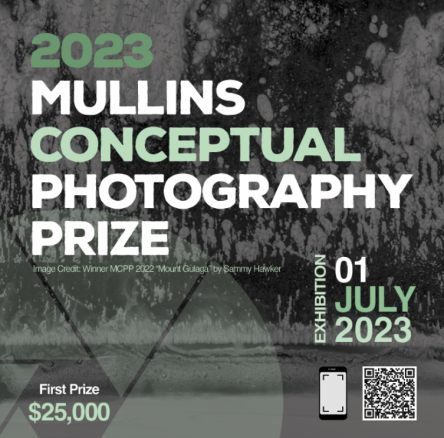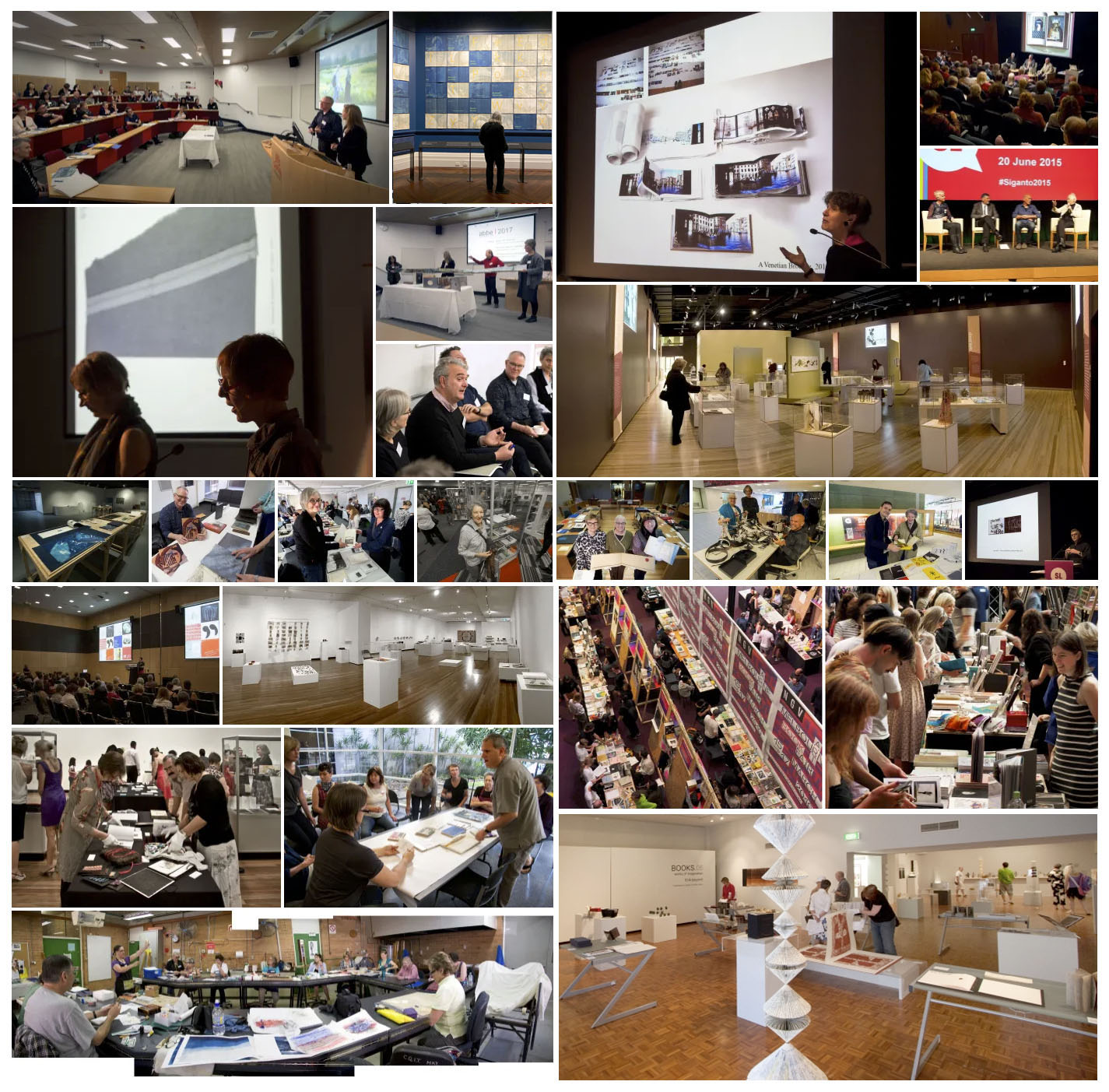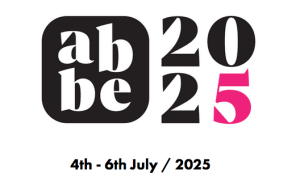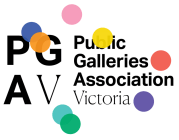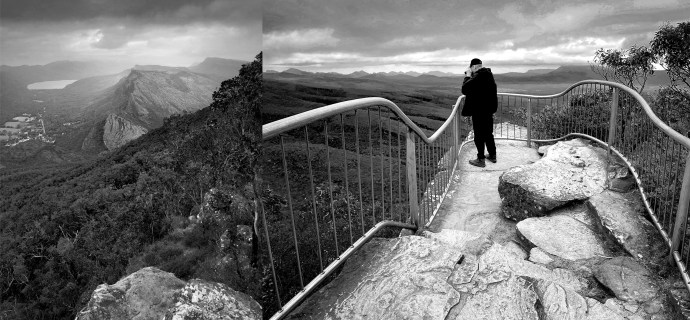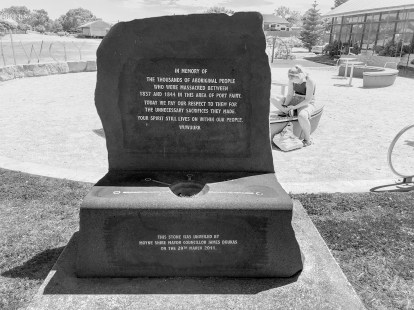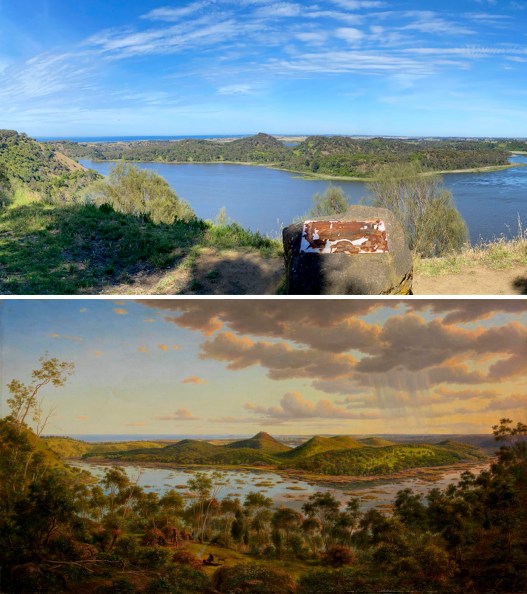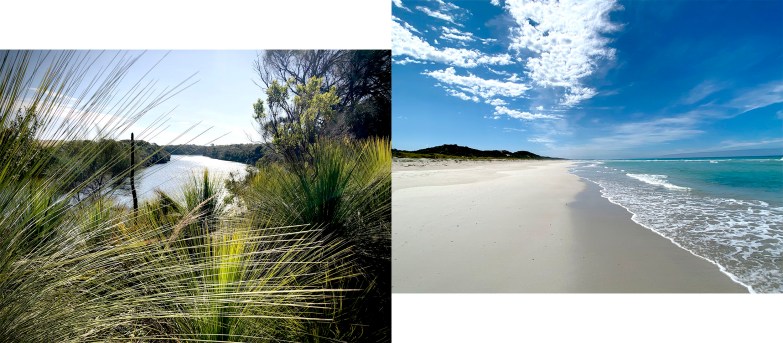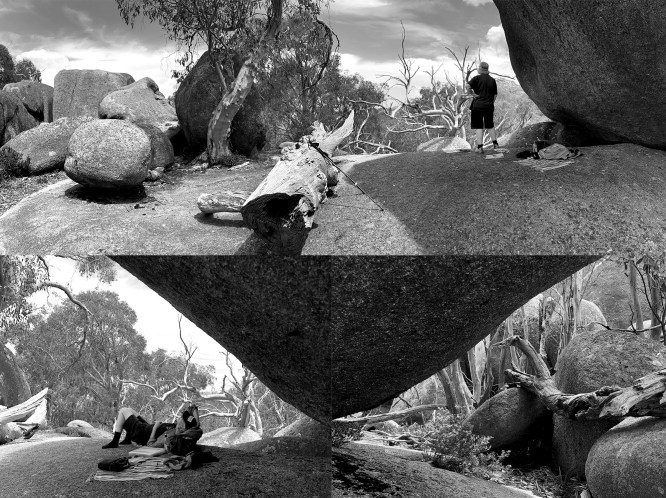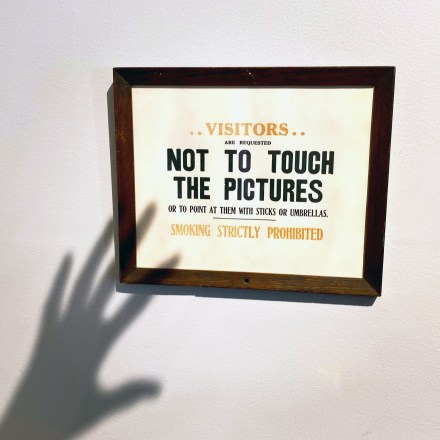2025 MULLINS CONCEPTUAL PHOTOGRAPHY PRIZE
..
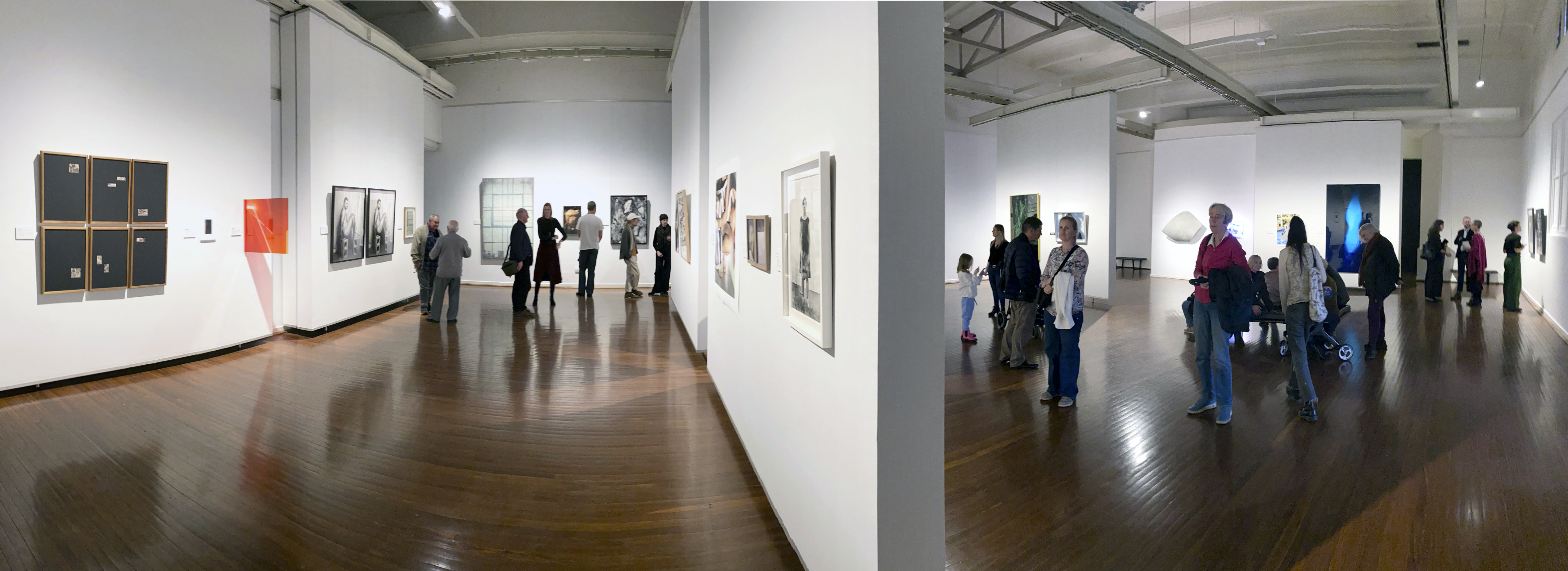
2025 Mullins Conceptual Photography Priz
.
2025 Mullins Conceptual Photography Prize
Muswellbrook Regional Art Centre 14 August – 11 October 2025
.
The Mullins Conceptual Photography Prize seeks artist entities that challenge the viewer via the illustration of a concept rather than being merely illustrative or representational.
The work must be primarily photographic but not to the exclusion of mixed media and three dimensional objects.
The Australian Photographic Society’s Mullins Conceptual Photography Prize is a national $30,000 acquisitive prize that seeks to find Australia’s best conceptual photographic works. Finalists of the prize are exhibited annually at Muswellbrook Regional Arts Centre with the prize-winning work joining the Muswellbrook Shire Art Collection, and a collection of contemporary photographic works acquired through the Muswellbrook Photographic Award (1987 – 2014). Means of work presentation are unrestricted, inviting photographers to illustrate the intent of their works through a myriad of mediums.
.
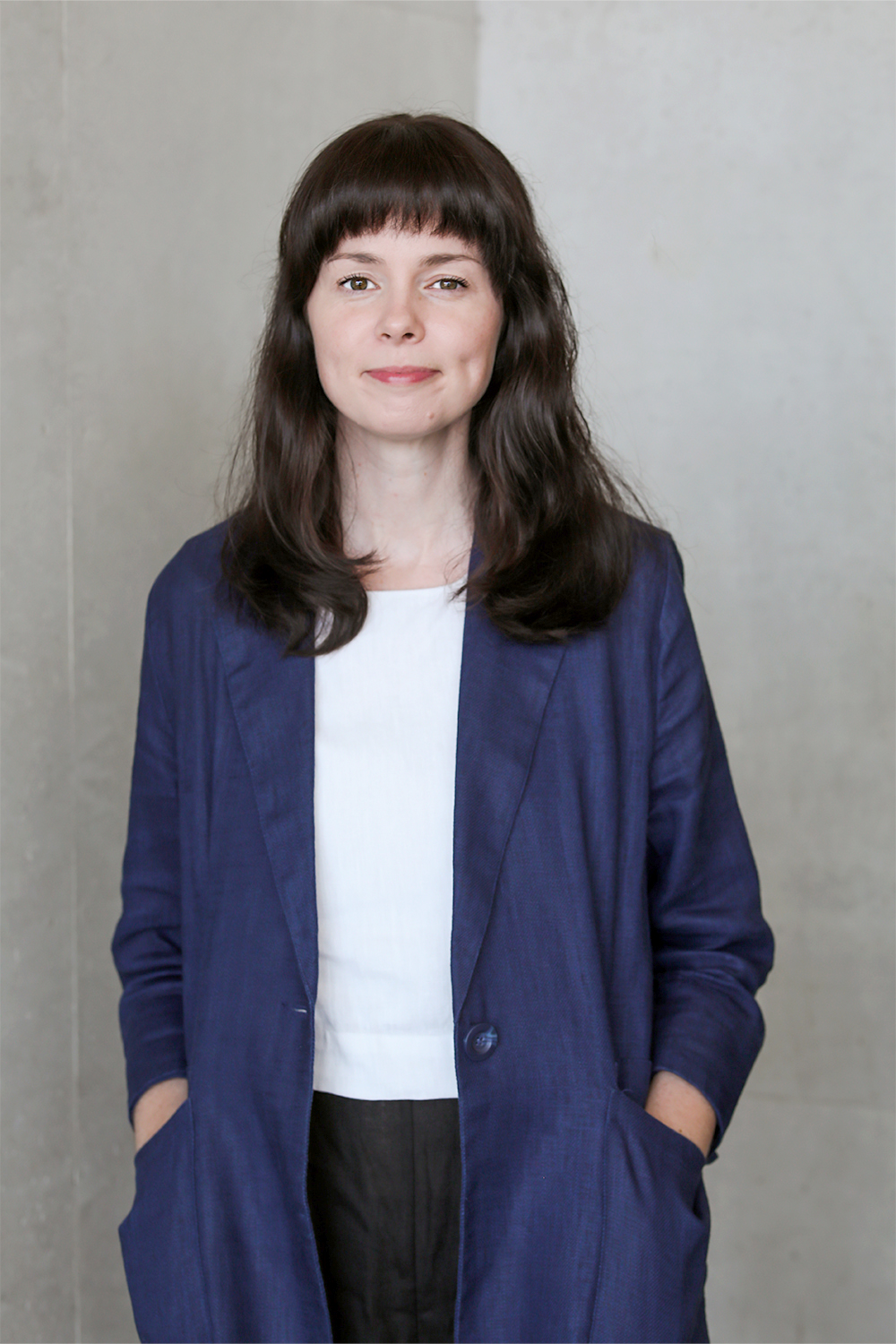
Antares Wells Assistant Curator MCA PHOTO: liya Cohen Headshots
ABOUT THE ADJUDICATOR (From the APS Instagram)
This year’s sole adjudicator is Antares Wells, Assistant Curator at the Museum of Contemporary Art Australia. Antares is a curator and writer with a specialisation in photography. Previously, she was Curator at the Powerhouse Museum, Sydney, and Curatorial Assistant in the Department of Photographs at the J. Paul Getty Museum, Los Angeles.
.
.
.
THE 30 FINALISTS (Selected from 366 entries)
Images supplied by the Mullins Conceptual Photography Prize. “Click” on the image to enlarge entry and to see maker and title.
.
.
.
.
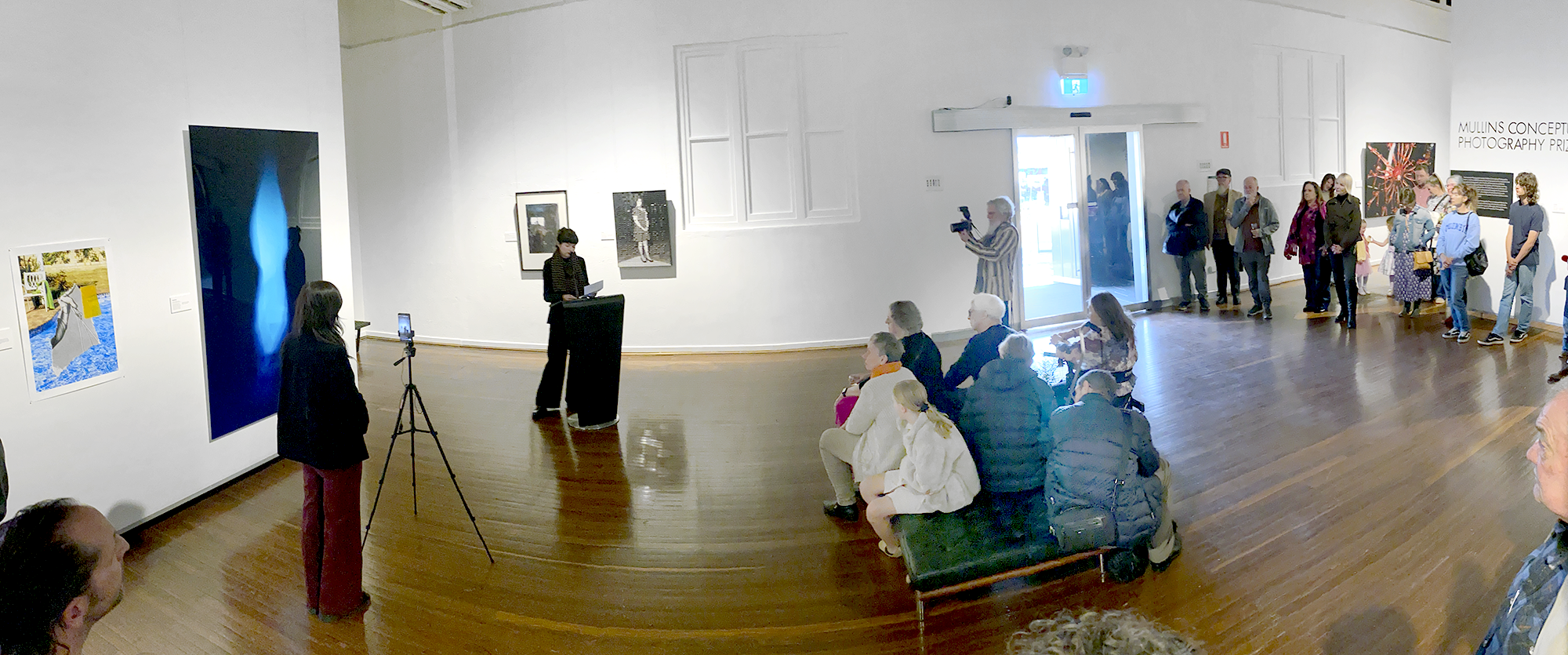
Antares Wells announces the Prize-cropped
.
THE ADJUDICATOR’S ADDRESS AND PRIZE ANNOUNCEMENT
Good afternoon everyone, and thank you all for coming. It’s wonderful to see so many people here celebrating contemporary photography. My name is Antares Wells and I am Assistant Curator at the Museum of Contemporary Art Australia. It’s an honour to have been invited by the Australian Photographic Society to judge the 2025 Mullins Conceptual Photography Prize and I am thrilled to be here with you today. I’d like to acknowledge the Wonnarua people as the traditional custodians of the lands on which we are gathering tonight and I pay my respects to elders past, present and emerging.
This year’s Mullins Conceptual Photography Prize received hundreds of entries from across the country and I am delighted to have selected 30 finalists for this exhibition. The work presented here spans the breadth of contemporary photographic practice in Australia.
Artists Justine Roche, Nicholas Hubicki, Claire Paul and Isabella Capezio engage thoughtfully with the natural environment and its relationship to photography, presenting work that reflects a deep consideration of materials. Works by Carolyn Craig, Shea Kirk and David Rosetzky critically consider the body, desire and the self. Artists Mungo Howard, Angus Brown, Lisa Stonham and Annabelle McEwen mine the relationships between photography and other media, such as painting and sculpture, encouraging us to think critically about what a photograph is.
Works by Skye Wagner, Claudia Nicholson, Darron Davies and Callan Skimin reframe existing found and archival imagery, creating new image worlds in the process that harness the photograph’s associative power. Artists Jeremy Drape, Jessie Turner and Julie Purdie experiment with perception and the capacity of the lens to frame a world.
Works by Dylan Marriott, George Angelovski, Kathy Mackey, and Tamara Voninski experiment with colour and form, while artists Izabela Pluta and Yvette Hamilton consider sites of photographic history and practice through formally ambitious works. Finally, Miho Watanabe, Hilary Wardhaugh, Ali Tahayori, Lilah Benetti, and Minami Ivory explore memory, trauma, loss, and possible futures, in quietly affecting and powerful ways.
For those of you drawn to processes of technical experimentation, you are in for a treat. We have artists who are working in new ways with historical processes, such as salt prints, wet collodion and opalotypes; we have artists inventing new processes, such as ‘chemography’; and we have artists working critically with new technologies such as 3D printing, moulding, and Artificial Intelligence.
As you can imagine, with this group of finalists it was incredibly difficult to identify a winner, and I thank Elissa, Brian and Roger for their patience over the past 48 hours!
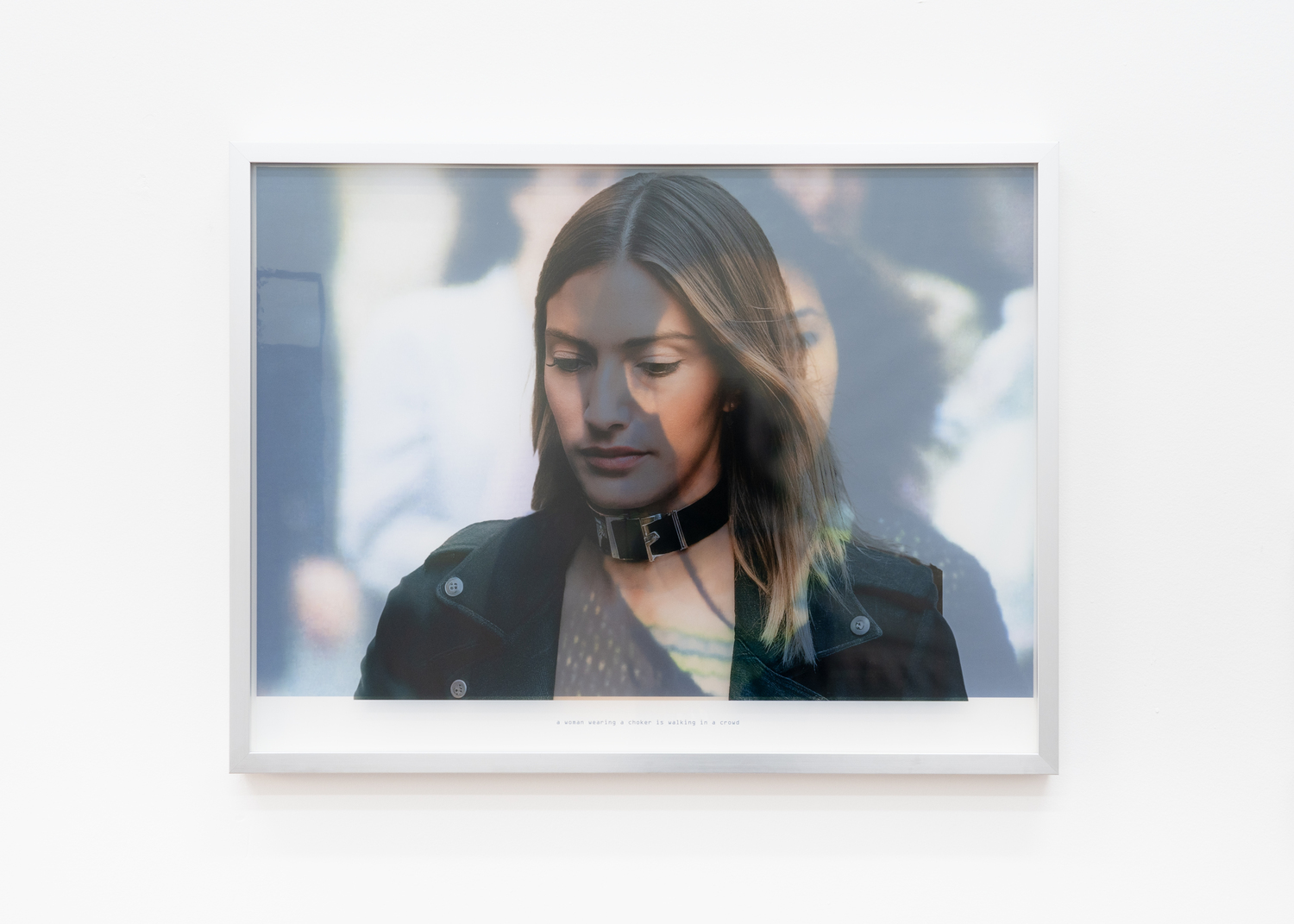
Johanna Ng – a woman wearing a choker is walking in a crowd, 2024
I am delighted to announce that the winner of the 2025 Mullins Conceptual Photography Prize is Johanna Ng, for her work a woman wearing a choker is walking in a crowd (2024). Drawn from her broader body of work every asian in sex and the city, Johanna’s work utilises screenshots of Asian extras in the TV show, often glimpsed in the background. Johanna writes in her statement: I “photographed the extras in new compositions” and then “fed these compositions through Google’s image-to-text and then text-to-image AI engines. Ultimately, an image of an Asian woman becomes ‘a woman’ and the text ‘a woman’ conjures the image of a white one.”
Johanna’s work is visually compelling and turns on its ability to make you stop, look, and then look again. There’s a dimensionality to it best experienced in person, which gives form to questions of visibility, erasure, and the biases structuring the image and text generation systems that are increasingly shaping how we see, think and behave. Congratulations, Johanna!
I am also pleased to award two works as Highly Commended:
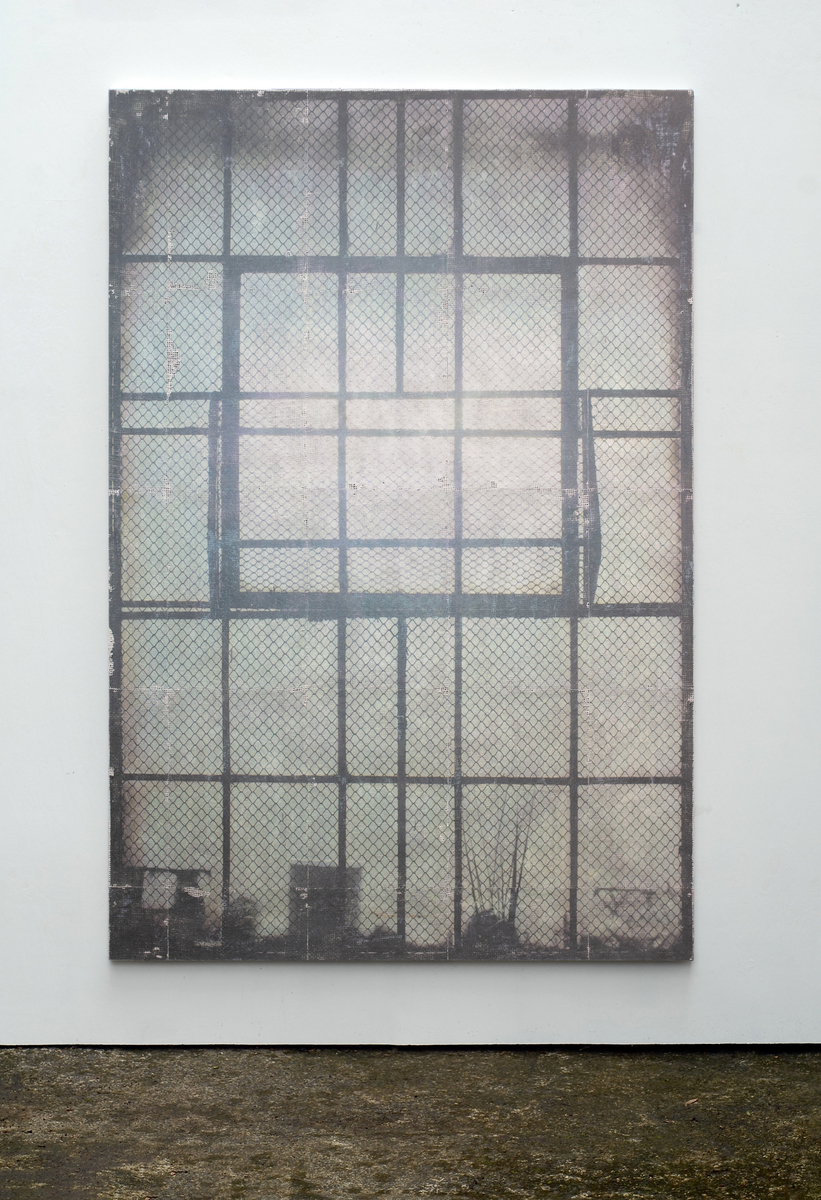
Mungo Howard – Studio Window, 2025
Congratulations to Mungo Howard for his work Studio Window (2025), a beautiful work hovering somewhere between painting, sculpture and photography, turning on the power of introspection.
.
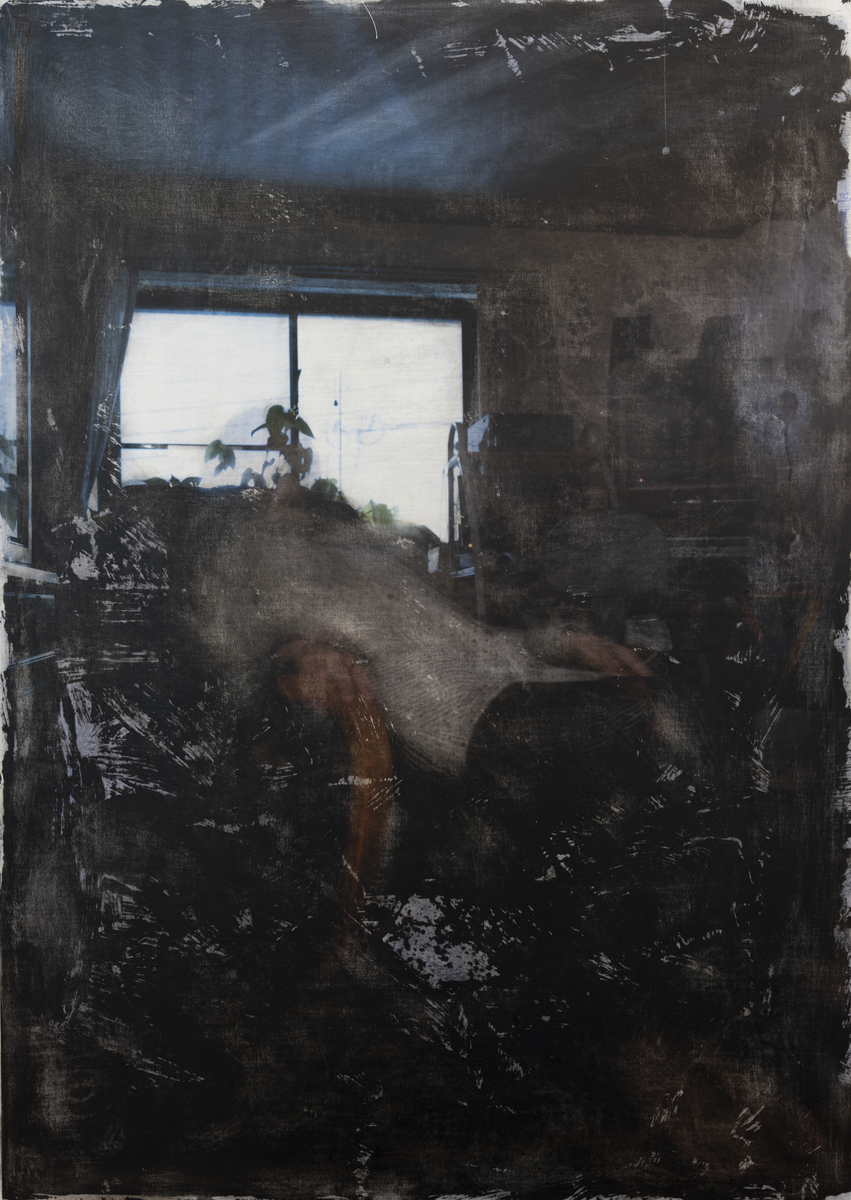
Miho Watanabe – Awareness of Between-ness A Day After My Father’s Departure – Self-Portrait in His Room on His Chair, 2025
Congratulations to Miho Watanabe for his work Awareness of Betweenness: A Day after My Father’s Departure – Self-Portrait in His Room on His Chair (2025), a quietly affecting meditation on memory, grief and the passage of time.
.
Congratulations to all of the finalists, and thank you again to Muswellbrook Regional Arts Centre and the Australian Photographic Society for having me as this year’s judge.
.
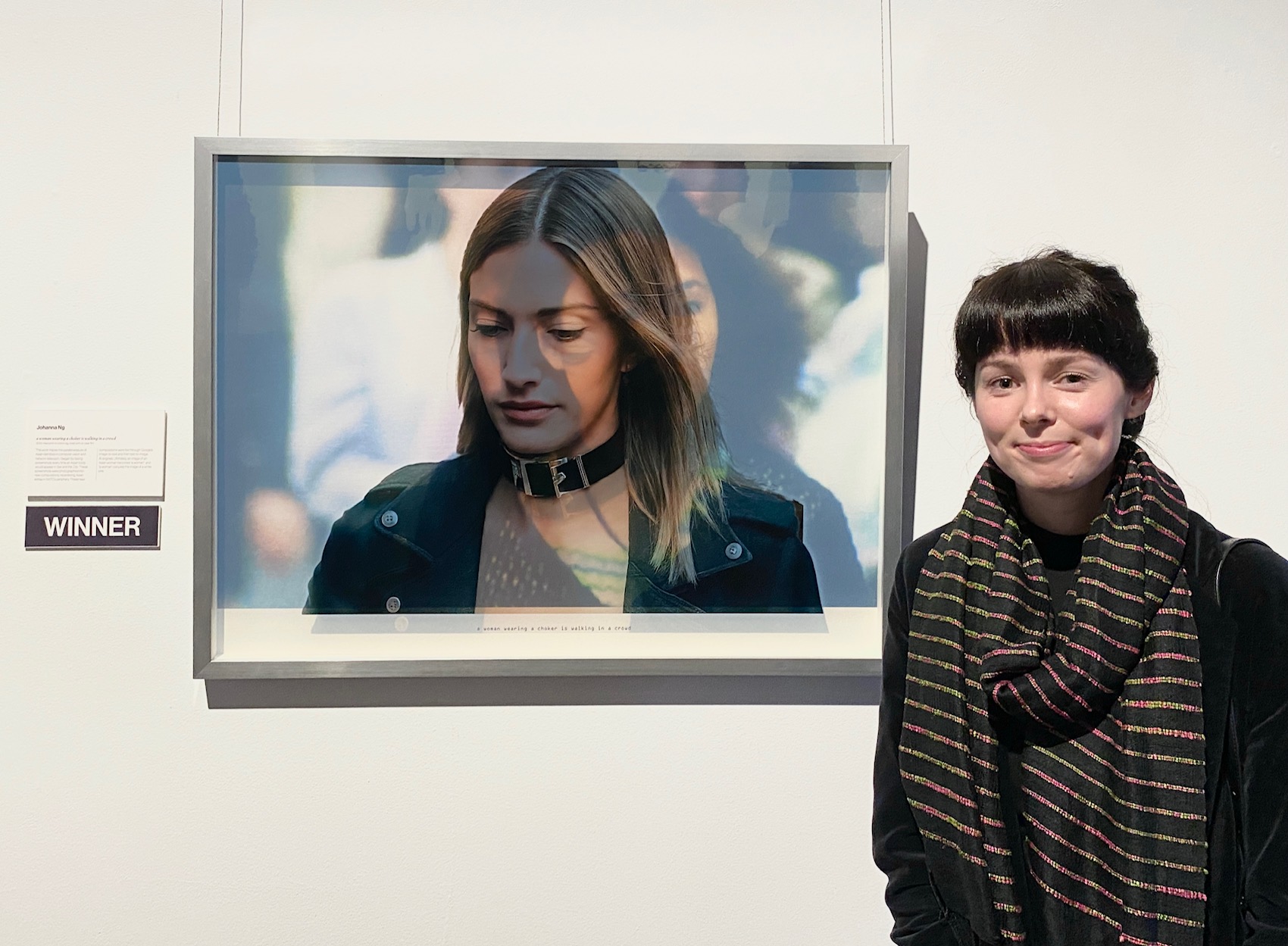
The Adjudicator Antares Wells with the winning entry
.
.
.
.
SOME DOCUMENTATION OF THE EXHIBITION OPENING EVENT
“Click” on the image to enlarge and see the caption.
.
.
.
SPONSORS OF THE MCPP
The 2025 Mullins Conceptual Photography Prize is made possible by the Australian Photographic Society in partnership with the Muswellbrook Regional Arts Centre, and with the support of Bengalla Mining Company, MACH Energy, Malabar Coal, AGL Hunter, and Australian Photography Magazine.
..
.
SEE OUR BLOG POST FOR THE
2023 MULLINS CONCEPTUAL PHOTOGRAPHY PRIZE
“Click” the link HERE
.
.
.
POSTSCRIPT: THE WINNER JOHANNA NG VISITS EXHIBITION
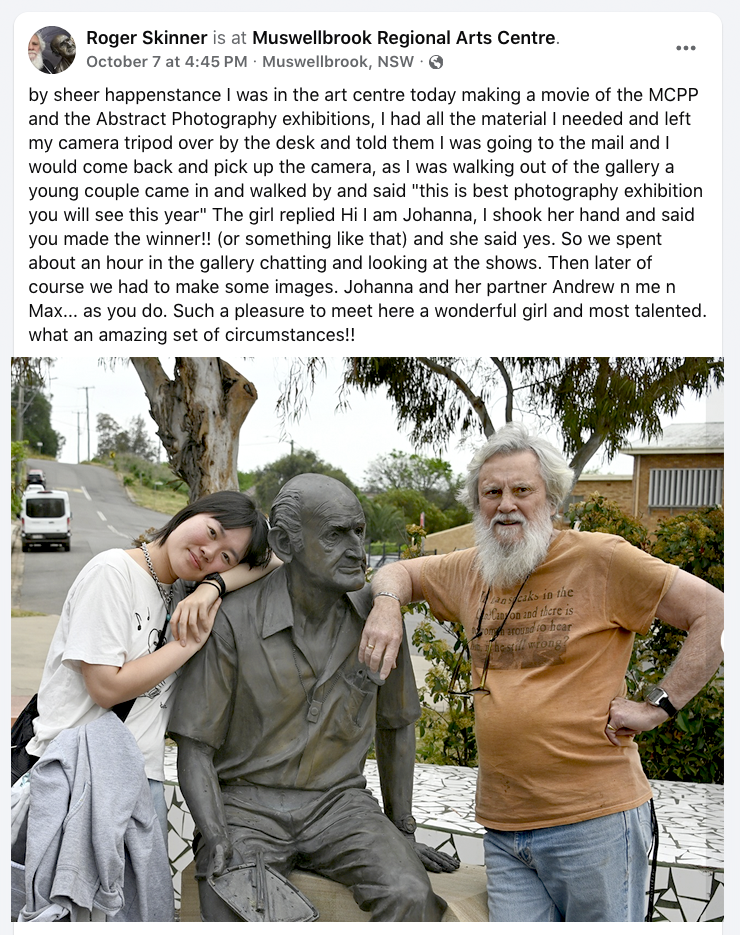
Johanna Ng+Roger Skinner with Max Watters’ statue PHOTO: Andrew
.
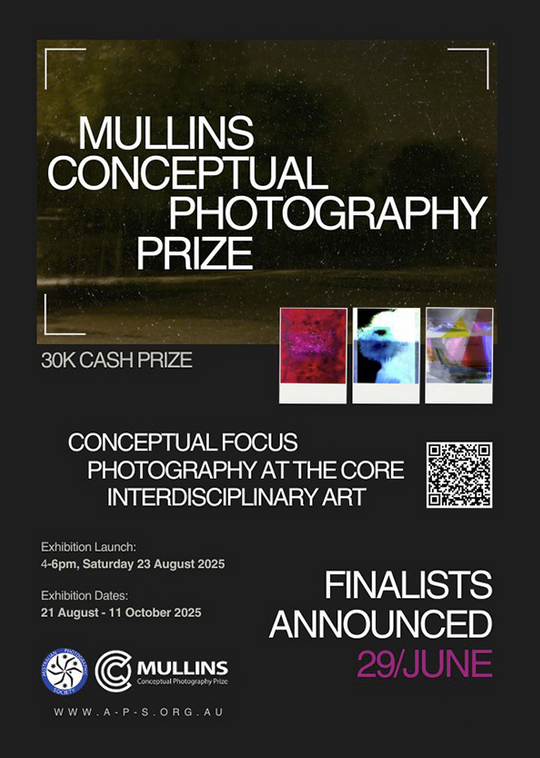
Mullins poster
.
Adjudicator’s address ©Antares Wells
All photographs of the MCPP exhibition at the Muswellbrook Regional Art Centre are ©Doug Spowart
.
.
.
.
.
.
2025 LIBRIS AWARDS Highly Commended to Cooper+Spowart book
..
.
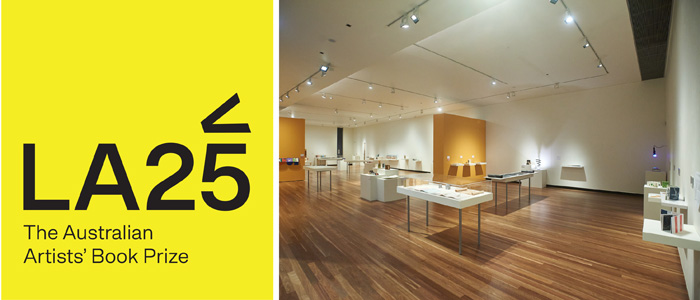
LIBRIS Website logo and image
.
2025 LIBRIS AWARDS: THE AUSTRALIAN ARTISTS’ BOOK PRIZE
.
Held biennially by Artspace Mackay the Libris Awards brings together artist book works by leading and emerging makers from across Australia. The awards celebrate the artform by providing a snapshot of the discipline at a particular time and place. Of the hundreds of submissions received this year 60 finalists were selected to compete for three award categories:
CATEGORY 1 – Daly Bay National Artists Book Award (acquisitive)
…………………– Daly Bay National Artists Book Award, Highly Commended (acquisitive)CATEGORY 2 – Cathy Knezevic Regional Artists Book Award (acquisitive)
CATEGORY 3 – Tertiary Artists Book Prize – an invitational award (acquisitive)
Award winning artists books are acquisitive and each Awards event build on the gallery’s nationally significant artist book collection.
ABOUT THE JUDGES (From the Awards website)
The 2025 Guest Judges were MARIAN MACKEN is a writer, researcher, educator, and artist trained in architecture, landscape architecture and visual art, and is currently Associate Professor at Te Pare School of Architecture and Planning, Waipapa Taumata Rau University of Auckland, New Zealand.
AND
ANA ESTRADA is a Brisbane-based socially engaged artist working in healthcare, exploring how art can be used to create safe spaces for dialogue. Her practice involves storytelling, photography, poetry, bookmaking, and, more recently, performance, all of which serve as crucial tools for voicing the experiences of aged care workers and residents.
.
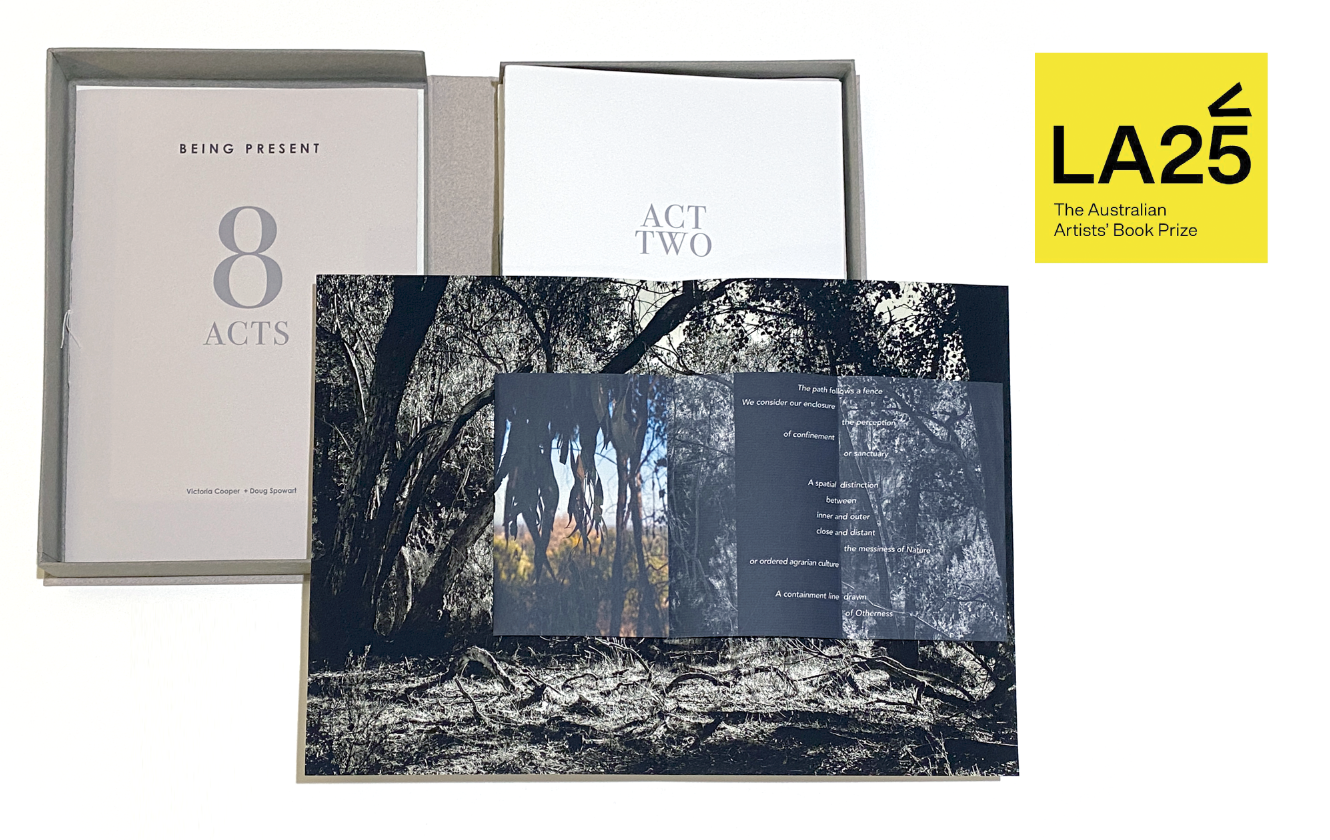
BEING PRESENT: Eight Acts – Image, Folders and clamshell
.
The Cooper+Spowart entry in this year’s Awards was our book Being Present: Eight Acts which was recently presented in a framed format in the Wangaratta Performing Arts Gallery.
Our artist’s statement was:
Walking is integral to our creative practice and being present in everyday life. These journeys, both physical and psychological, are not driven by the necessity to arrive at a determined end point but to meander and be aware of the possibilities in each step. Walking and Being Present also refers to the concept creation in, and performative actions of material thinking in the making of our book works.
Through a combination of materials and book forms, ‘Being Present: Eight Acts’ invites the reader to enter each scene and join us on a slow walk through time, space and considerations of ‘being in the world’.
We were excited to be advised that the book was judged as ‘Highly Commended’ by the judges and acquired for the Artspace Mackay Collection. While unable to attend the Award presentation event we forwarded the following words that were read by Gallery Director Tracey Heathwood.
We are deeply honoured to receive the Daly Bay Highly Commended Award in this prestigious exhibition and award. The Libris Awards is an important event to the artist book community, and we are thrilled with the knowledge that our book will now be included in the highly acclaimed Artspace Mackay artists book collection.
‘Being Present: Eight Acts’ evolved over many months of deep questioning and material thinking. The concept of walking and performance through both the physical and psychological space of the book is deeply embedded in both the making and reading of this book. It is an invitation the reader to enter each scene and join us on a slow walk-through time, space and an awareness of being in the world.
We wish to thank the sponsors Daly Bay for their support and the continued commitment that Artspace Mackay makes to the artists book community. We also wish to thank the Judges who we have taken care and time to connect with all the amazing books that have been presented to them for this award.
Thank you
.
THE 2025 AWARD WINNERS
.
CATEGORY 1
WINNER Daly Bay National Artists Book Award (acquisitive)
.
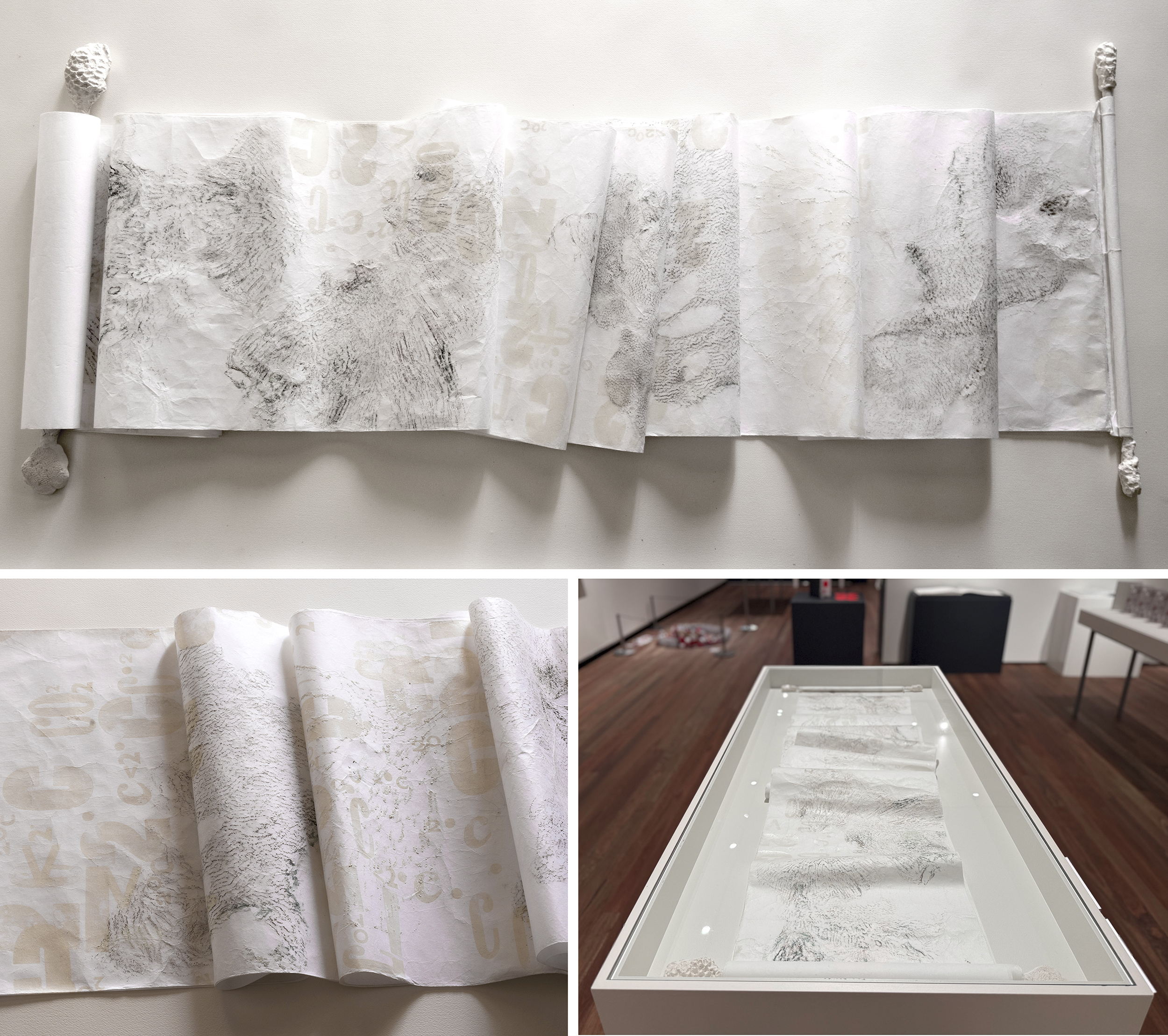
Jude Taggart Roberts Less than 2 degrees 2025
.
Jude TAGGART ROBERTS Less than 2 degrees 2025
Drawing, relief print on Hosho with paperclay, 160.0 x 46.0 x 4.0cm (open).
Images courtesy of the artist and Artspace Mackay
.
.
.
HIGHLY COMMENDED Daly Bay National Artists Book Award (acquisitive)
.
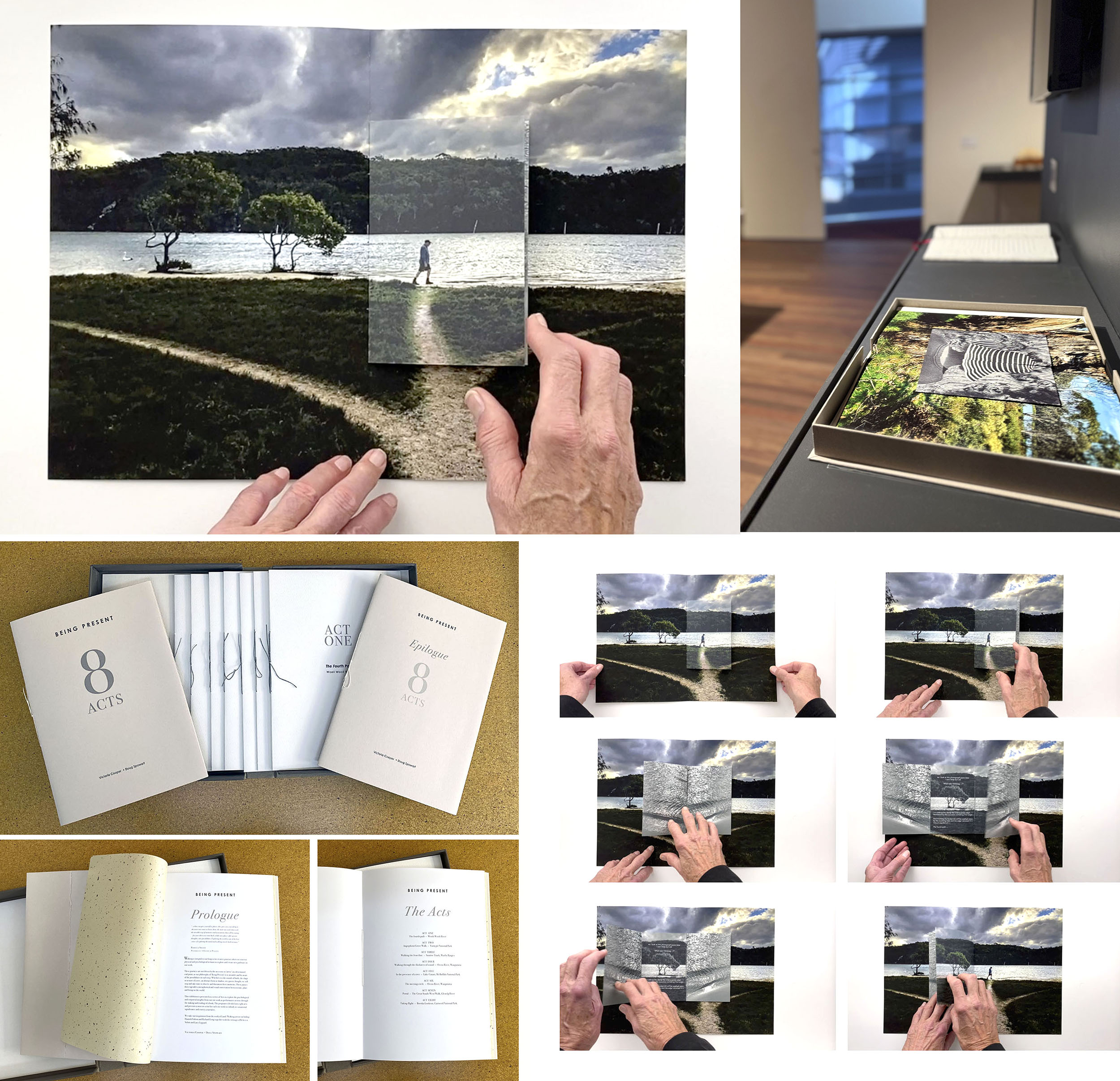
COOPER+SPOWART Being Present – Eight Acts 2024
.
Victoria COOPER and Doug SPOWART Being Present: Eight Acts 2024
Pigmented inks on photographic and art papers, edition of 3 + 1 AP, 31.0 x 22.0 x 3.5 cm
Images courtesy of the artists and Artspace Mackay
.
.
.
CATEGORY 2
Cathy Knezevic Regional Artists Book Award (acquisitive)
.
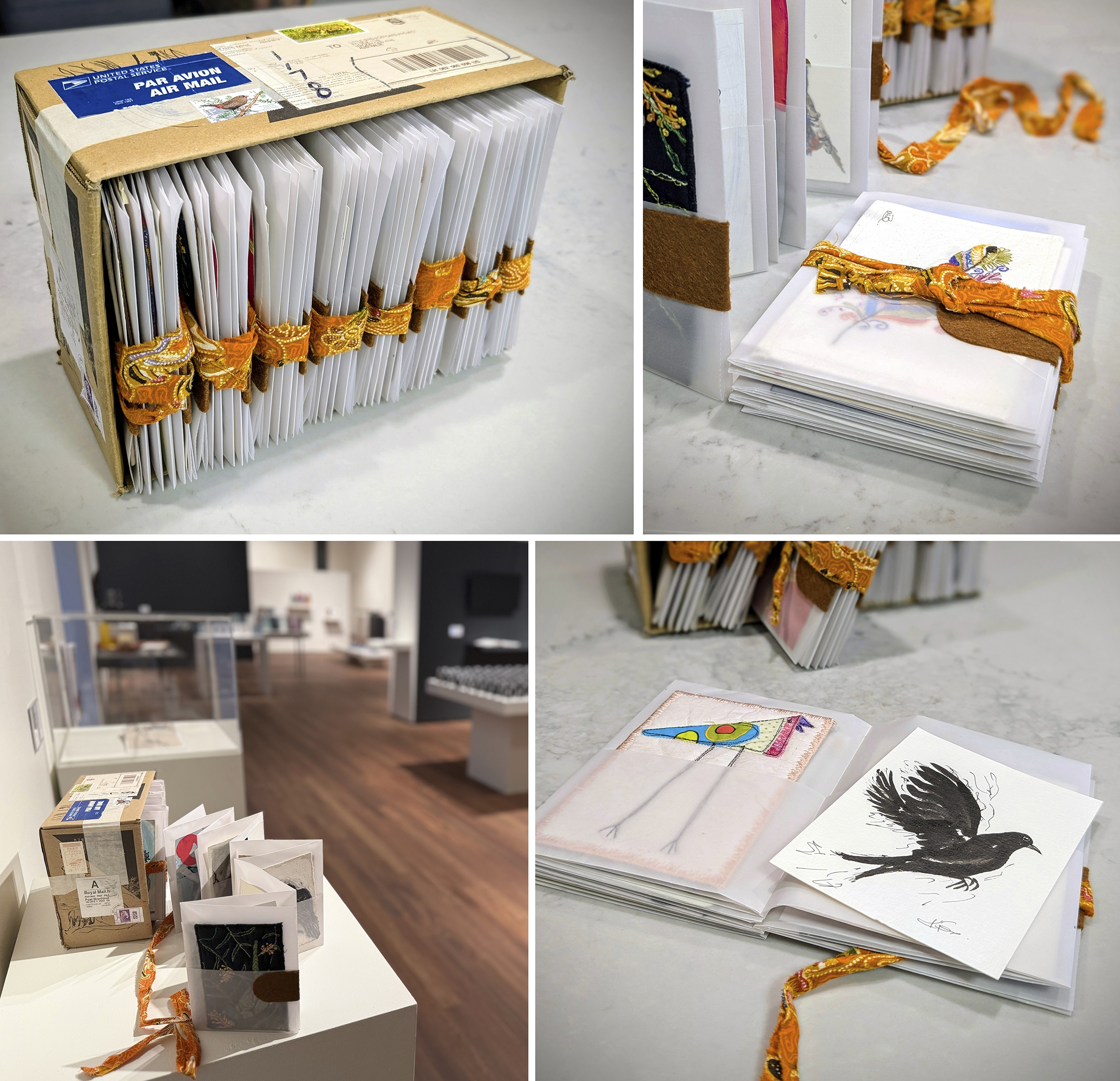
Karen Hurford & Natalie Field The Little Bird Compendium 2025
.
Karen HURFORD and Natalie FIELD The Little Bird Compendium 2025
Mixed media, 19 x 27.0 x 13.0 cm. Images courtesy of the artists and Artspace Mackay
.
.
.
CATEGORY 3
Tertiary Artists Book Prize – An invitational award (acquisitive)
.
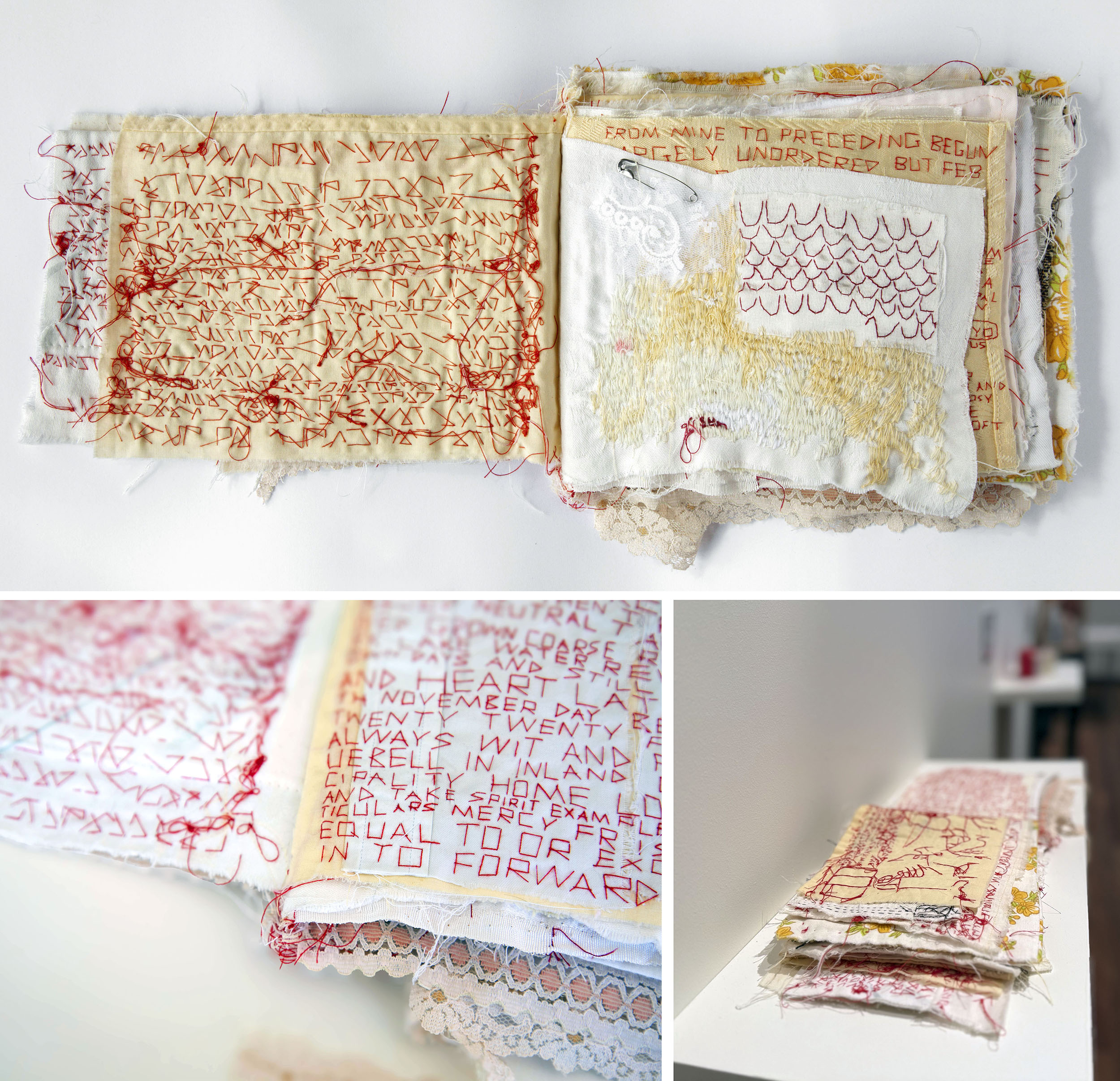
Megan Kennedy Hold Hands Spring Tide 2025
.
Megan KENNEDY Hold Hands Spring Tide 2025
Mixed media, 20.0 x 22.0 x 4.0 cm (closed), 20.0 x 44.5 cm dimensions variable (open).
Images courtesy of the artist and Artspace Mackay
.
.
.
The 2025 Libris Award: The Australian Artists’ Book Prize exhibition will be on display at Artspace Mackay until the 14th of September.
.

LIBRIS Website logo and image
.
.
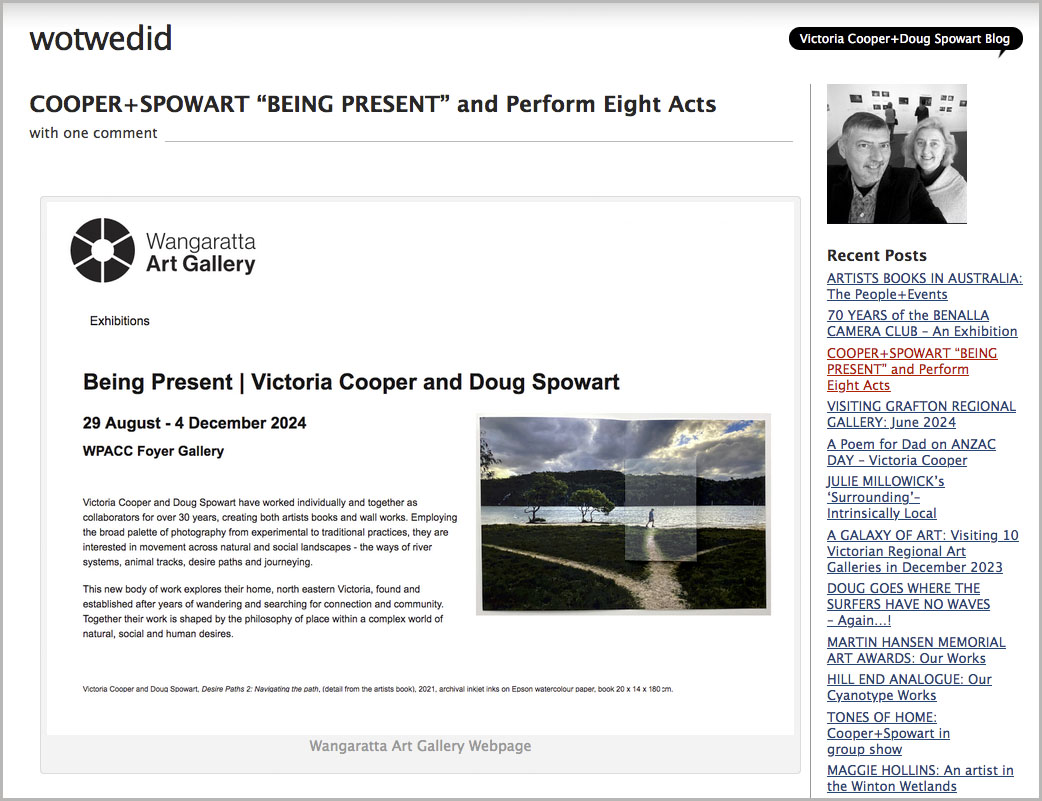
WOTWEDID Blog page
READ MORE ABOUT OUR BEING PRESENT BOOK AND EXHIBITION: BEING PRESENT WOTWEDID BLOG POST 2024
.
..
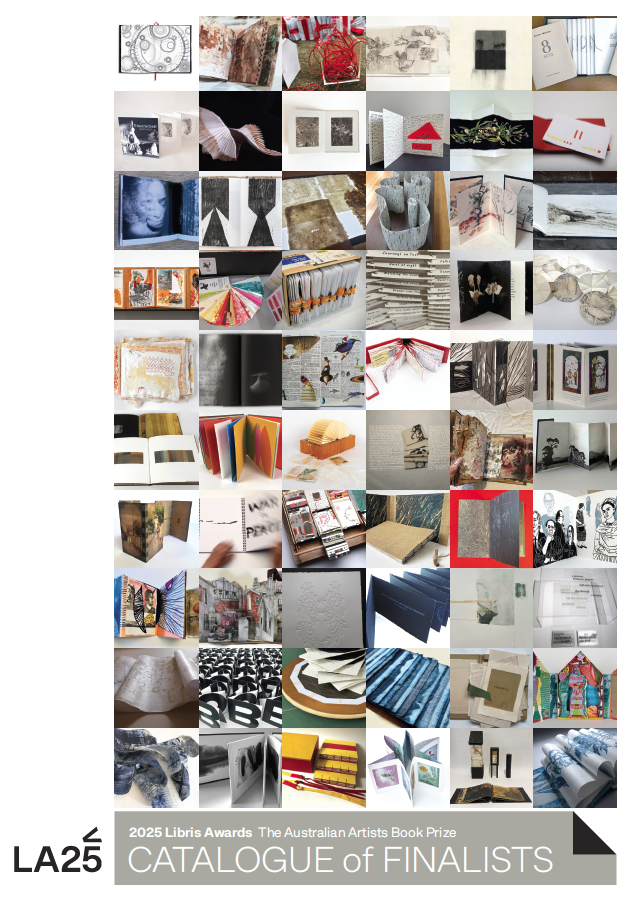
Libris Finalists Catalogue cover
DOWNLOAD AN ILLUSTRATED CATALOGUE HERE: 2025 Libris Finalists Catalogue
.
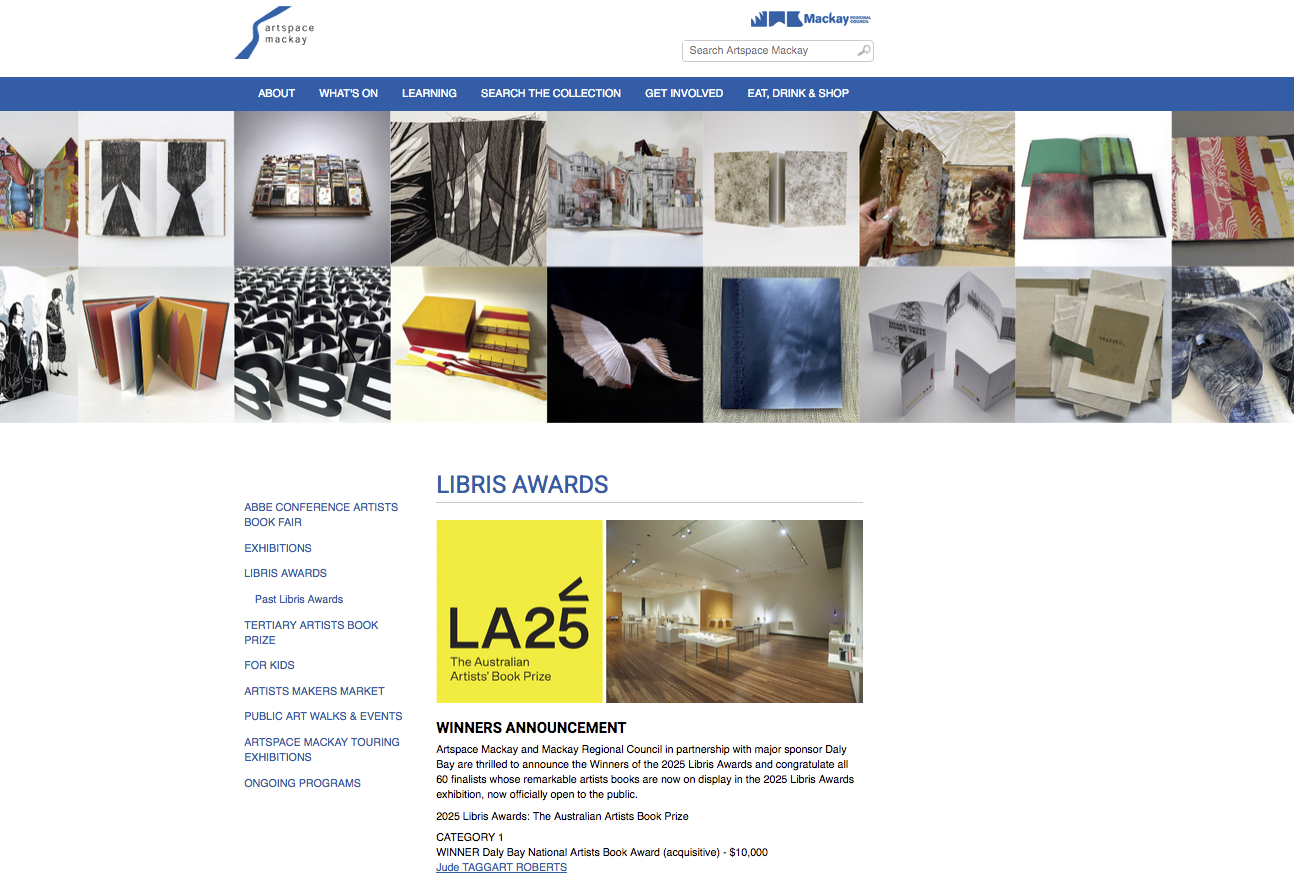
Artspace Mackay website
FURTHER INFORMATION ABOUT THE AWARD: THE LIBRIS WEBSITE
.
.
.
WATCH THIS SPACE …
.
.
A
.
.
.
.
.
.
.
.
70 YEARS of the BENALLA CAMERA CLUB – An Exhibition
..
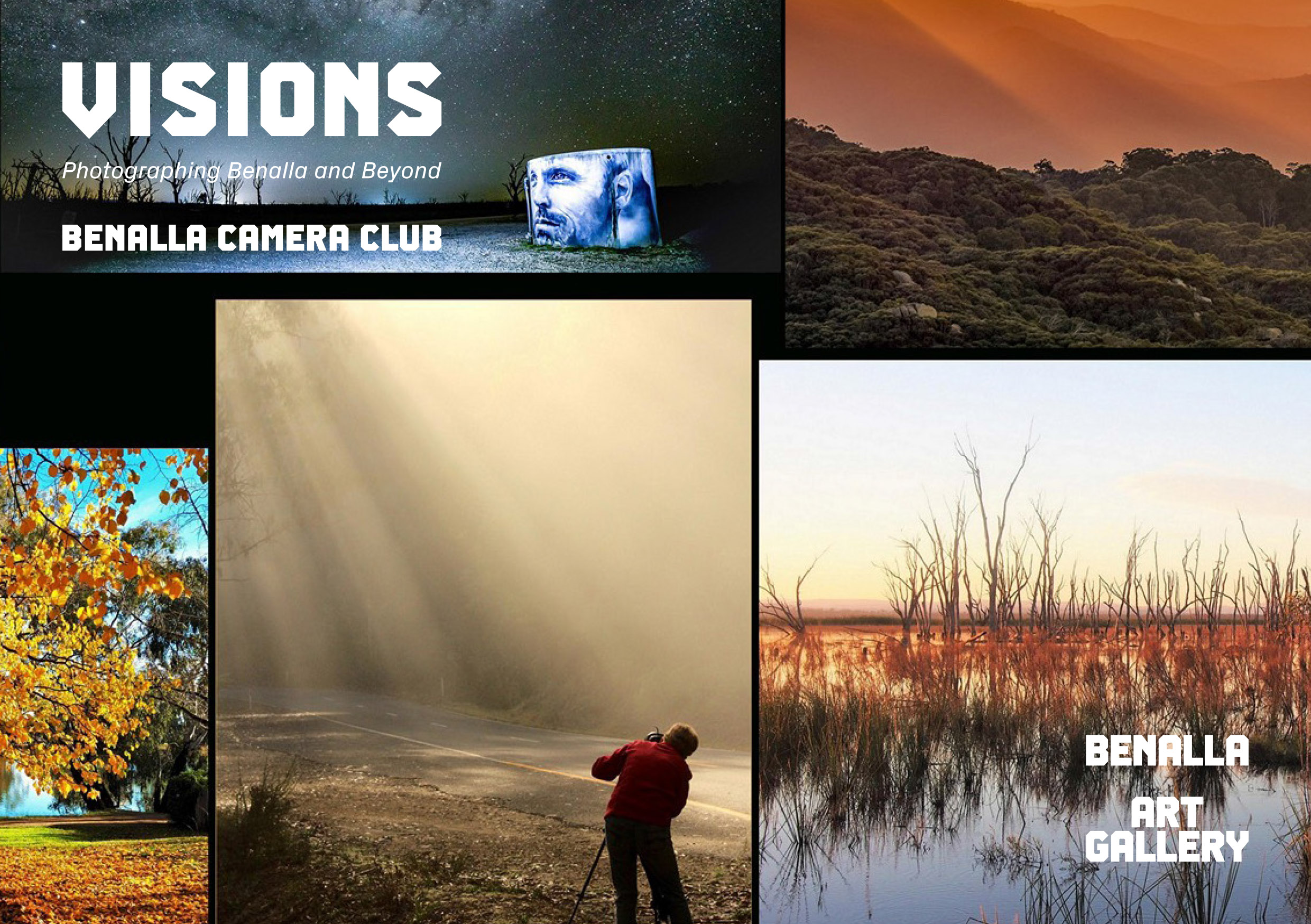
.
.
VISIONS: Photographing Benalla and Beyond
An exhibition celebrating the 70th Anniversary of the Benalla Camera Club at the Benalla Art Gallery October 15 – December 8 2024
.
.
In early 2024 we were invited by the Benalla Camera Club to participate on the organising team of an exhibition that celebrated the Club’s 70th anniversary of its founding in 1954. From October to December this year the club’s showcase was to be held in the Simpson Gallery space of the Benalla Art Gallery. As members of the club, we were excited to be able to contribute to the project through our knowledge and experience of exhibition production.
The team included artist Kym Stubbs, digital designer and technician Mike O’Connor, Club Treasurer and club historian Judy Barry and the two of us. At the beginning of the project the team met with Benalla Art Gallery Director Eric Nash to discuss the gallery’s requirements and process for the exhibition. Meetings of the committee, and at times included Eric, continued at regular intervals throughout the project.
.
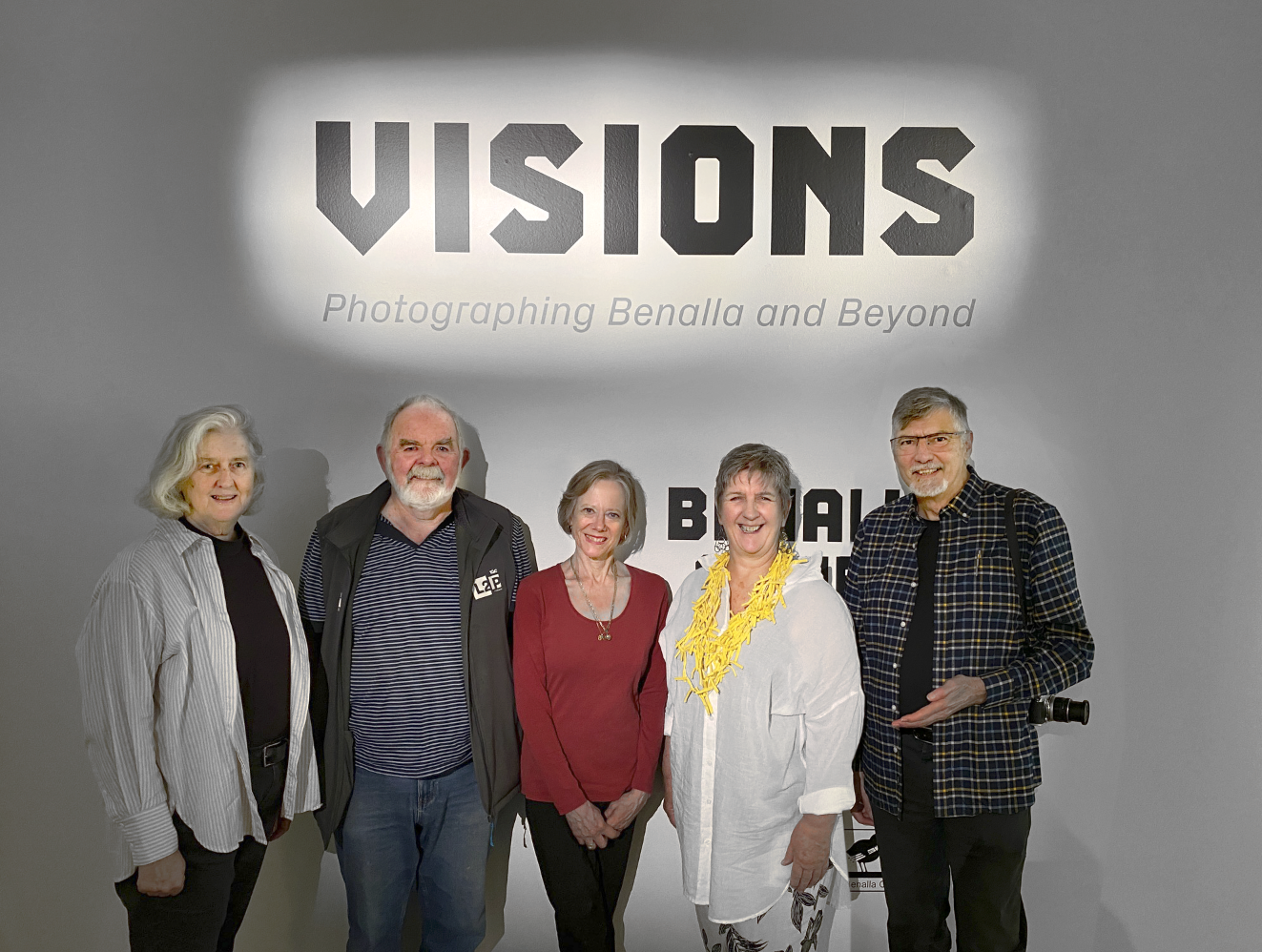
The Team – Benalla Camera Club VISIONS exhibition
.
Early in the project we presented a suggested layout that included a large image mosaic around 7 metres long for one wall, a large projected image screen, a showcase of equipment and a timeline. To make for a dynamic experience for viewers in the centre space of the gallery, team member Kym suggested 3D sculptural collections of boxes with images affixed to them.
.
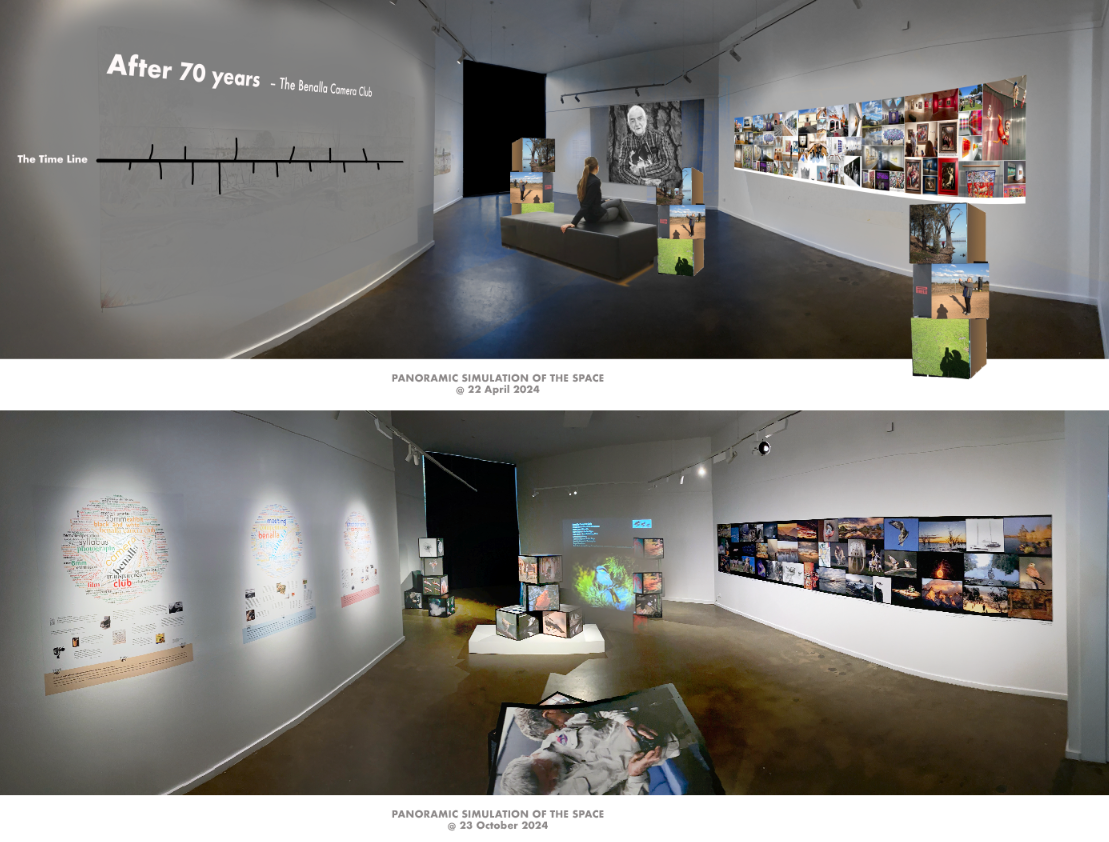
Proposal and final install of Visions Exhibition
.
The key theme was to celebrate the club’s current membership while highlighting references to, and stories from, the past 70 years. Concepts and ideas were refined and the exhibition gradually took shape to be an innovative and contemporary display. Special challenges were set for Mike experimenting methods for ganging images together for the montage mural and the printing of images for the boxes. Kym experimented with sizes and arrangements for the boxes and their placement in the gallery space. She also sourced a local manufacturer to make the boxes and then, with fellow club member Helen Repacholi, painted and prepared the boxes. The Gallery already had engaged a local master printer Marty Burke Signs for the adhesive backed vinyl wall mural and other didactic panels. Apart from general project coordination our task was to collate and prepare a timeline from information supplied by the club historian Judy.
.
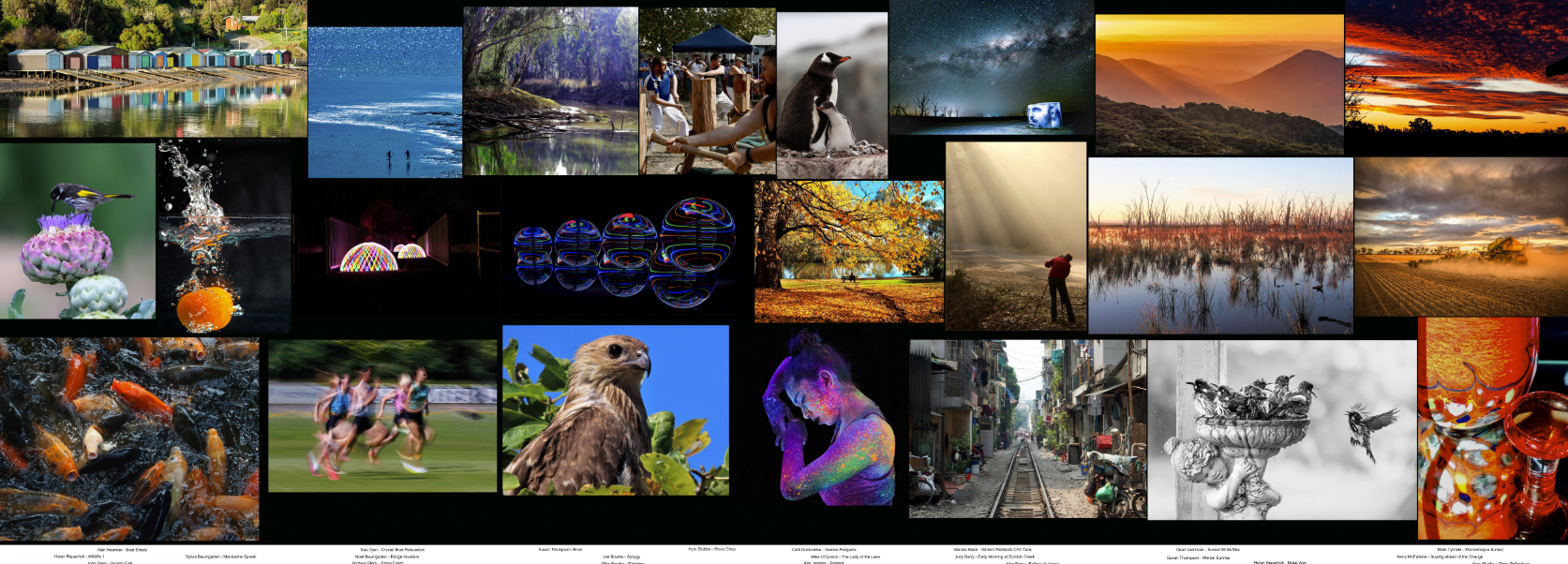
A section of the Visions montage
.
Images by current club members were to be presented in the exhibition in many formats. The largest was a photographic montage 8 metres long featuring 44 images. A further 80 images appear on Kym Stubbs’ boxes with around 44 images, and an early movie, in digital projection slide show – all of which were collected and assembled by Mike O’Connor. Kym and Mike collaborated on the selection of image sets for the boxes.
.
THE INSTALL
In the days before the opening the camera club team members along with Eric and the Gallery team worked to install the exhibition.
.
.
THE OPENING
.
The exhibition was opened on October 18, 2024 by the club Vice President Noel Baumgarten, with other speeches by Dom Testoni CEO Benalla Rural City Council, and Eric Nash Director of the Benalla Art Gallery.
In his introductory remarks at the opening Gallery Director Eric was to make the following comments –
Exhibitions such as this are incredibly important as they speak directly to the diversity and vibrancy of Benalla’s artistic community; those who pursue their artform with passion and dedication. In doing so these creative members of our community are not only benefitting personally, but they are enriching our entire region. And what an incredible thing that the Benalla Camera Club has been doing this for our community for 70 years! A round of applause please everyone on an incredible milestone.
And I think it’s wonderful within this exhibition that we can not only celebrate some stunning images by current members, but also through the illustrated timelines gain an appreciation of the full scale of those changes; stretching back to 1954 when the Club staged competitions centered on Kodachrome film, and 16, 8 and 35mm black and white film, to an adoption in recent years of the online platform MyPhotoClub for the administration, judging, and presentation of photo competitions.
.
THE TIMELINE EXHIBITION COMPONENT
Our task was to resolve the Timeline component of the exhibition. We worked to find ways to incorporate the great volume of text material collated by Judy that had been sourced from local newspaper clippings from the Benalla Ensign and club reports. We selected three time periods to generally represent the eras of photographic practice over the 70 years: 1954–1969, 1970–1999 and 2000–2024. To present the information from each era in a visually interesting way we fed the gathered texts relating to that period into a ‘word cloud’ app. The resulting graphic created by the app was a circular design where the size of each word was determined by the number of times it appeared in the text.
.
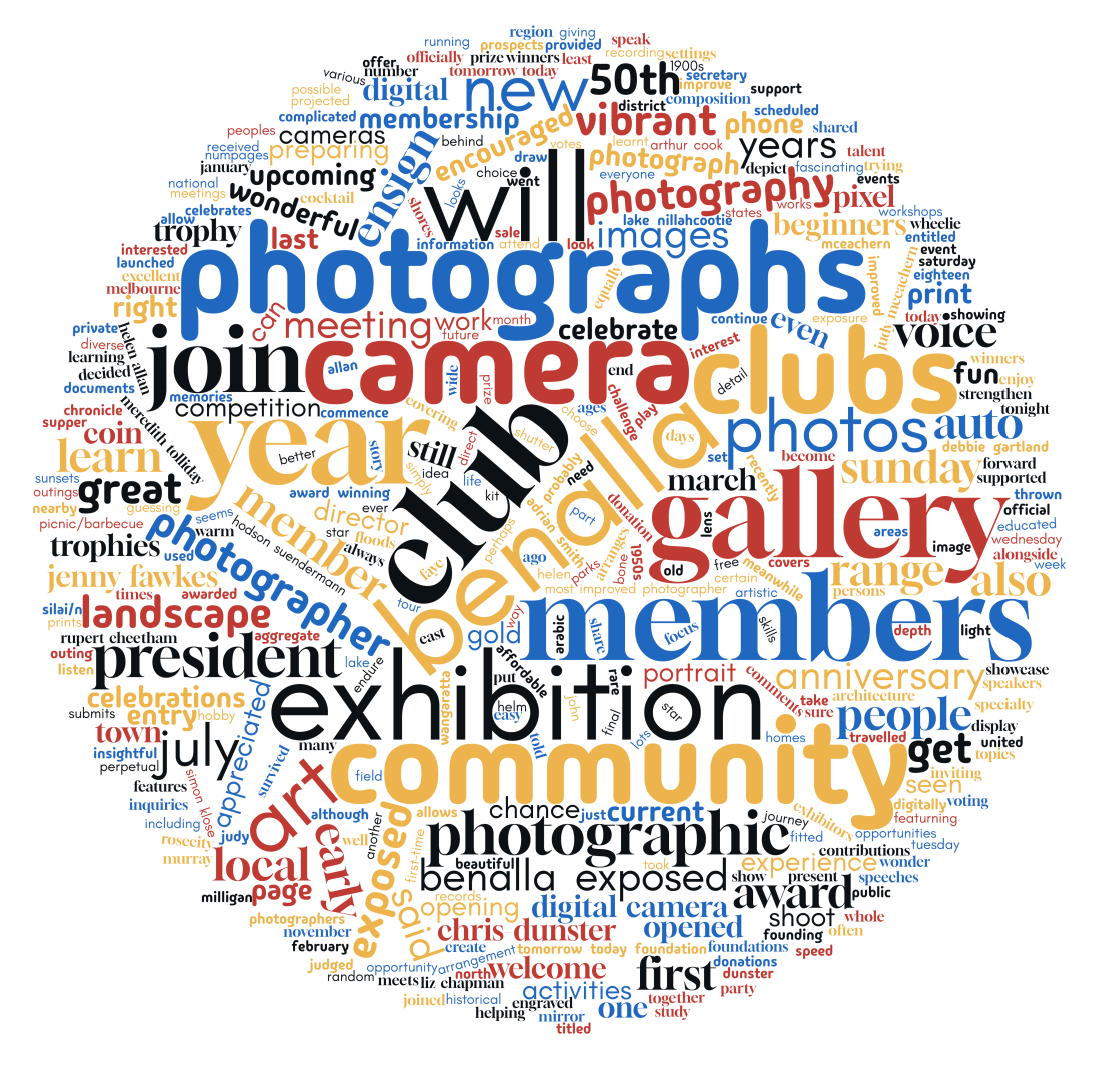
Timeline word cloud for 1970-1999
.
An additional element to the Timeline was a succinct history of photography over the 70 years highlighting changes and transitions in technology and the change from analogue (film) to digital capture and output. Here’s a sample of this text from 1970-1999.
.
“TOWARDS A PHOTOGRAPHIC TIMELINE FROM THE 1970s to the 1990s – A Brief Commentary
ART MOVEMENTS AND APPROACHES TO MAKING PHOTOGRAPHS: Pictorialism (popular in camera clubs), Modernism and Post-Modernism, Documentary and Art – the foundation of the Australian Centre for Photography
PHOTOGRAPHIC IMAGING TECHNOLOGY: Analogue along with digital technology development of digital imaging and output in the 1990s
IMAGING DEVICES: Analogue camera brands with new digital still and movie cameras in the 1990s including Kodak, Sigma, Sony, Samsung, Canon, Nikon, Pentax and Fuji
CAPTURE MATERIALS: Analogue materials persisted although in the late 1990s digital emerged as the dominant technology. Flatbed and film scanners created opportunities to bring analogue materials into the digital space
PRESENTATION TECHNOLOGIES: Prints, projectors for slides and movies were gradually replaced by digital projectors with screens and speakers
SPECIALISED TECHNOLOGY: Darkrooms became redundant and were replaced by computers and digital imaging programs like Adobe Photoshop. Inkjet printing with desktop devices began to replace professional laboratories. In the 1990s the Internet became the medium for sharing and disseminating digital files”.
.
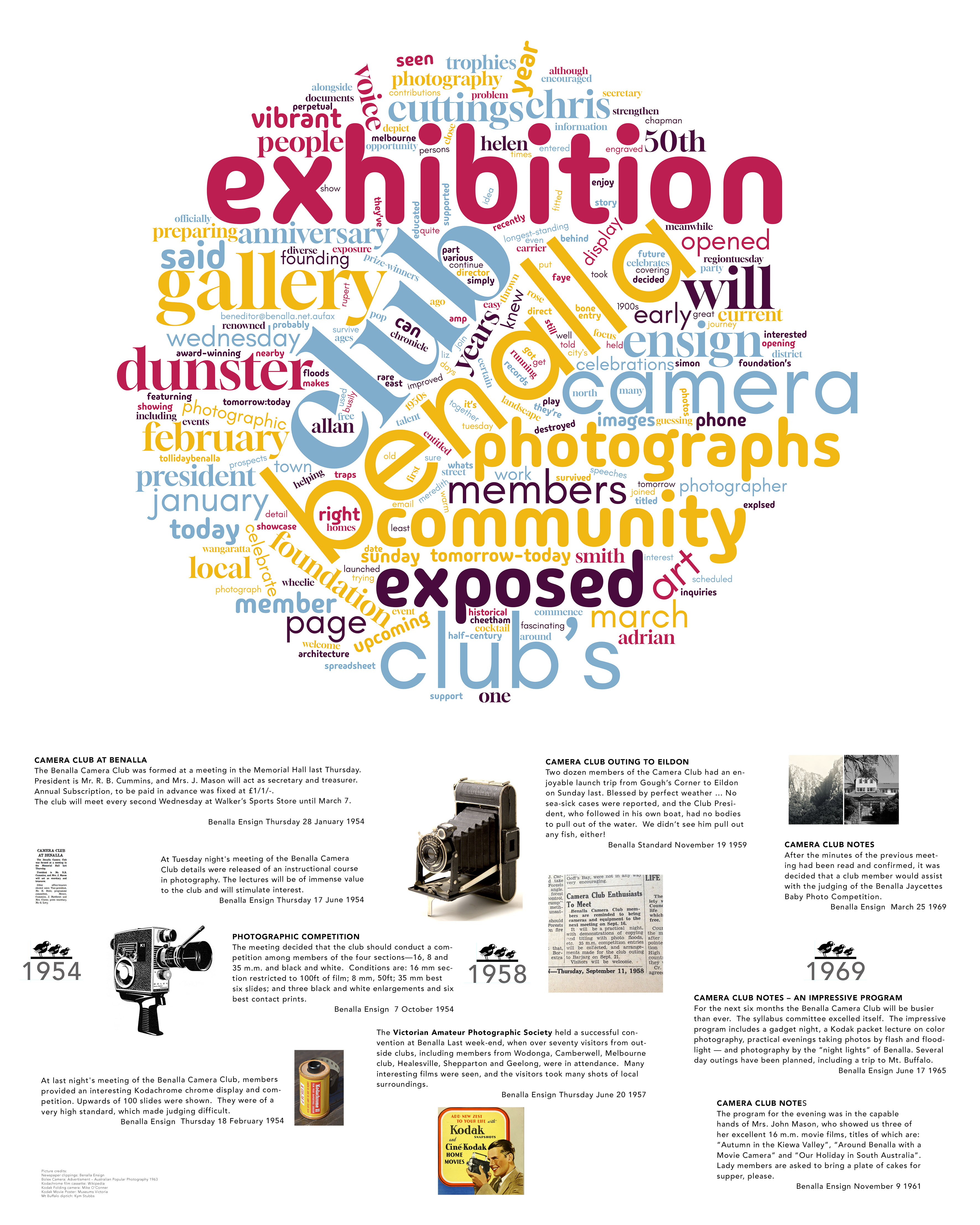
Benalla Camera Club Timeline 1954-1979
.
An additional Timeline element were small quotes from the newspapers that describe the activities of the club at that time …
.
(CLICK ON EACH TEXT BLOCK TO ENLARGE)
.
IN CONCLUSION
It was exciting to be part of the team that created this innovative presentation of the Benalla Camera Club. Importantly the exhibition presents the visual record in many photographic styles from artistic representation to documentary, and abstract to natural history recording. As photography enthusiasts the club members are a part of a world-wide community. Through personal expression and creativity, they provide visual statements of the times in which they lived and stories of their community. Their manifesto states:
“Today our club continues to explore expanding opportunities for photography. As well as creating images of the world around us, we pursue a range of techniques and photo-making experiments to capture the world beyond the scope of the human eye. We can be found with camera in hand at every community occasion. Through our regular club competitions, activities and excursions, we work to share our knowledge, skills and experience of the art and craft of photography with the wider community. (From the Gallery didactic)
.
Congratulations Benalla Camera Club and their members on their 70 years of operation – we look forward to seeing the Club thrive in the next 70 …
.
Victoria Cooper+Doug Spowart
.
.
.
More Information About the Benalla Camera Club
The Benalla Camera Club is a local club, with current membership of approximately 30 active photographers. The Club meets monthly for photo competitions, workshops, activities and outings. Anyone interested in photography is welcome to attend meetings and learn more about the Club, which caters to all photographers from beginner to advanced. To learn more or become involved, visit: www.benalla.myphotoclub.com.au
.
.
.
.
.
.
COOPER+SPOWART “BEING PRESENT” and Perform Eight Acts
..
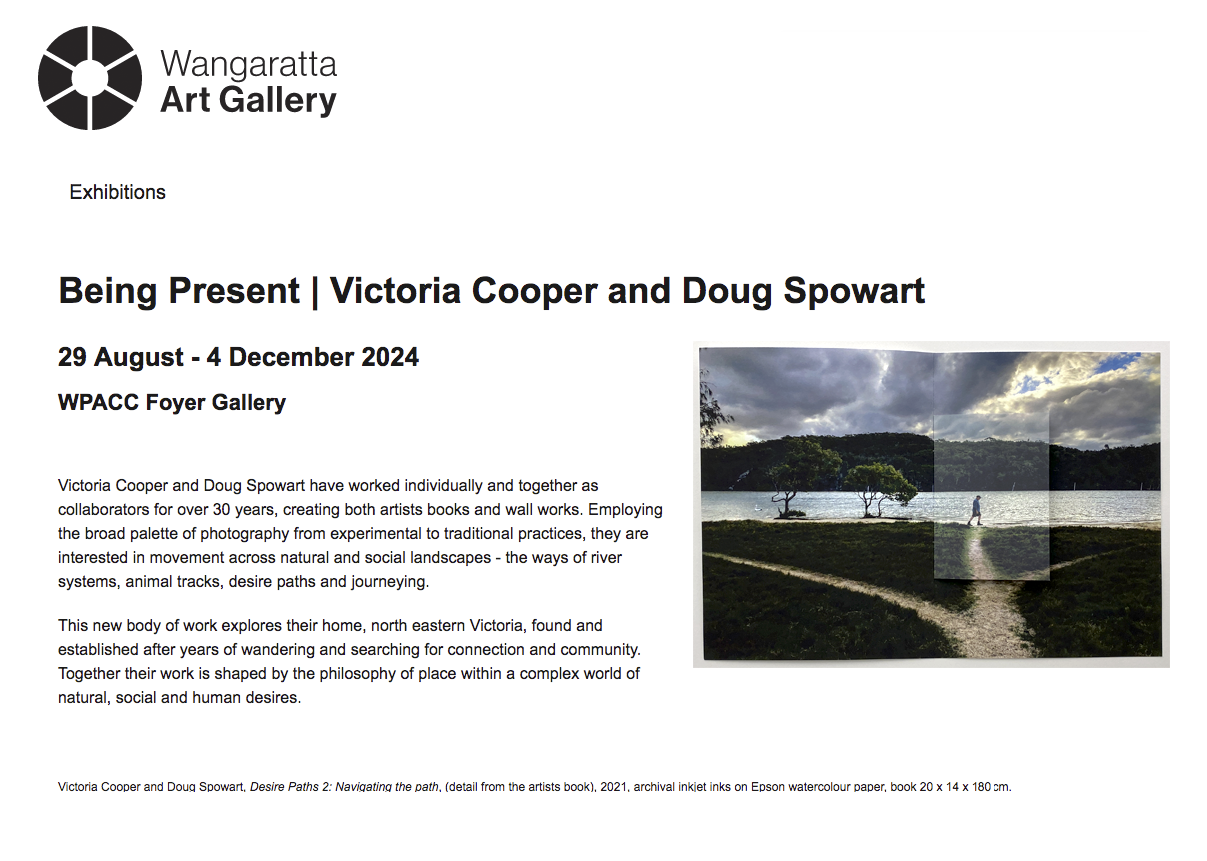
Wangaratta Art Gallery Webpage
.
THE STORY ABOUT THE WORK
A long-term underlying driver of our creative practice both individual and collaborative is linked to a philosophy of Being Present. Our work responds to a variety of conditions and influences including historical that relate to the contemporary experience of a place, space and time.
This bookwork and exhibition is the culmination of work started in December last year when we were offered a show by the Wangaratta Art Gallery Director Rachel Arndt in the Wangaratta Performing Arts Centre (WPAC). Very early in the project, Arndt selected the image of Doug walking along the Wooli Wooli River to be the featured image. This image holds a lot of meaning for us as it is emblematic of our long journey along many paths following new directions in our creative and personal life.
In the WPAC space we could only present framed work as a requirement for the organisation due to the complexity of presenting off the wall art in that public space. As our medium is artists books and photobooks with wall art to support the concept, we were then confronted with the dilemma of how to present an exhibition that was potentially an artists book. We forged ahead, confident that this would be resolved as we materially worked through the project.
.
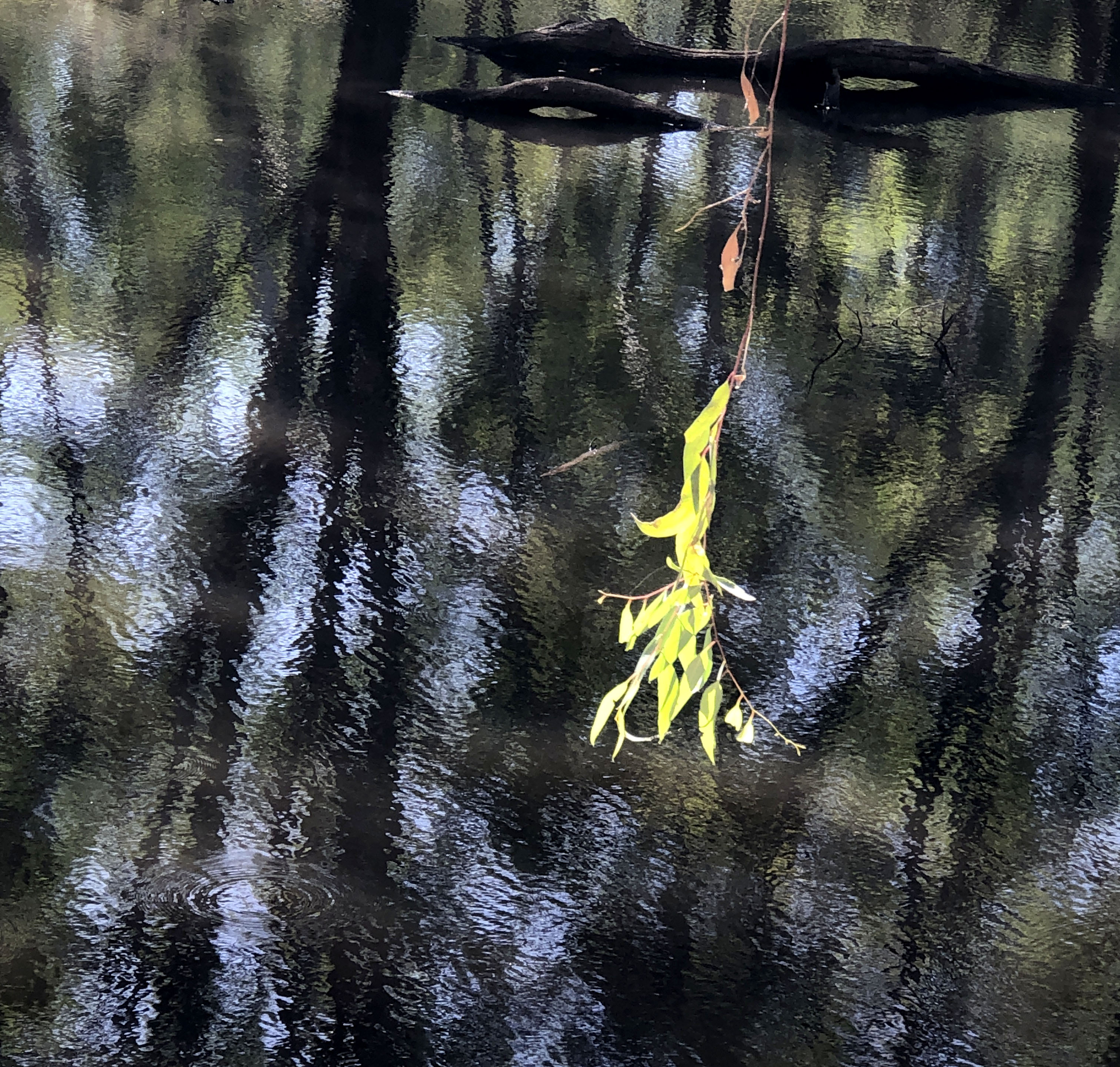
Ovens River Wangaratta
.
Following on from recent work in the nearby Winton Wetlands (Mokoan) and our Desire Paths series of books, we began the project by exploring tracks within the local place of Wangaratta, the Ovens River and the Warby Ranges.
During this time we also returned to the place of the Wooli River walk in northern NSW where we further developed the conceptual and creative work.
At this time we identified and drew upon a connection to the exhibition space as a site that related to our practice that involves self-documentation as a performative exploration of each concept.
The book was now taking shape as a series of Eight Acts that brought together our physical and psychological documentation together with the concepts of performance. As Arndt highlights in the exhibition didactic our work is:
… not driven by the necessity to ‘arrive’ at a determined end point, but instead guided by a shared philosophy of ‘being present’ – to meander and be aware of the possibilities in each step. Attuned to the sounds of birds, the texture or shape of a tree, an abstract form or shadow, or a poetic thought, they will stop and take time to observe and document these moments, each pause a metaphorical and visual conversation between time, place and being-in-the-world.
.
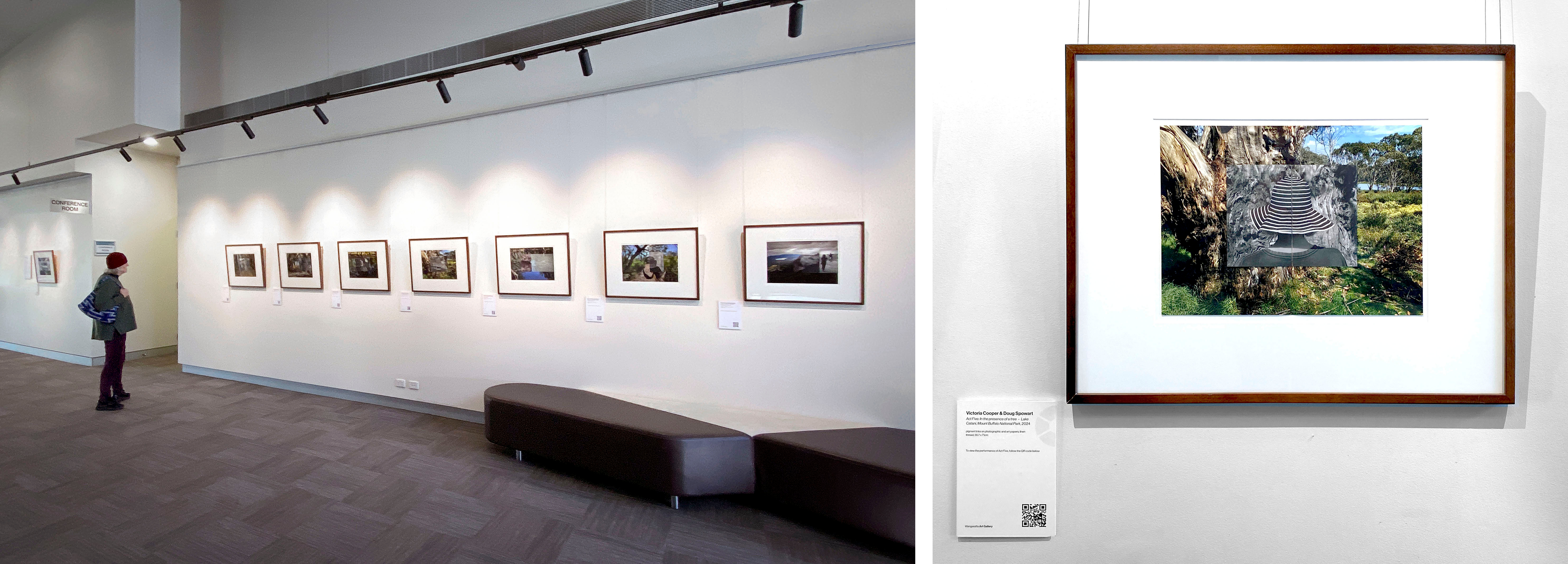
Being Present: 8 Acts installation
.
Presented as a series of eight ‘Acts’, Cooper and Spowart’s new body of work explores the psychological and corporeal insights of their walking practice. Their performative actions are captured through the making and reading of a book, with each framed work presenting one page turned and exposed, while another is hidden below. Just as one leg steps forward, the other remains behind in shadow. The ground, or their mise-en-scene, bringing situational significance.
.
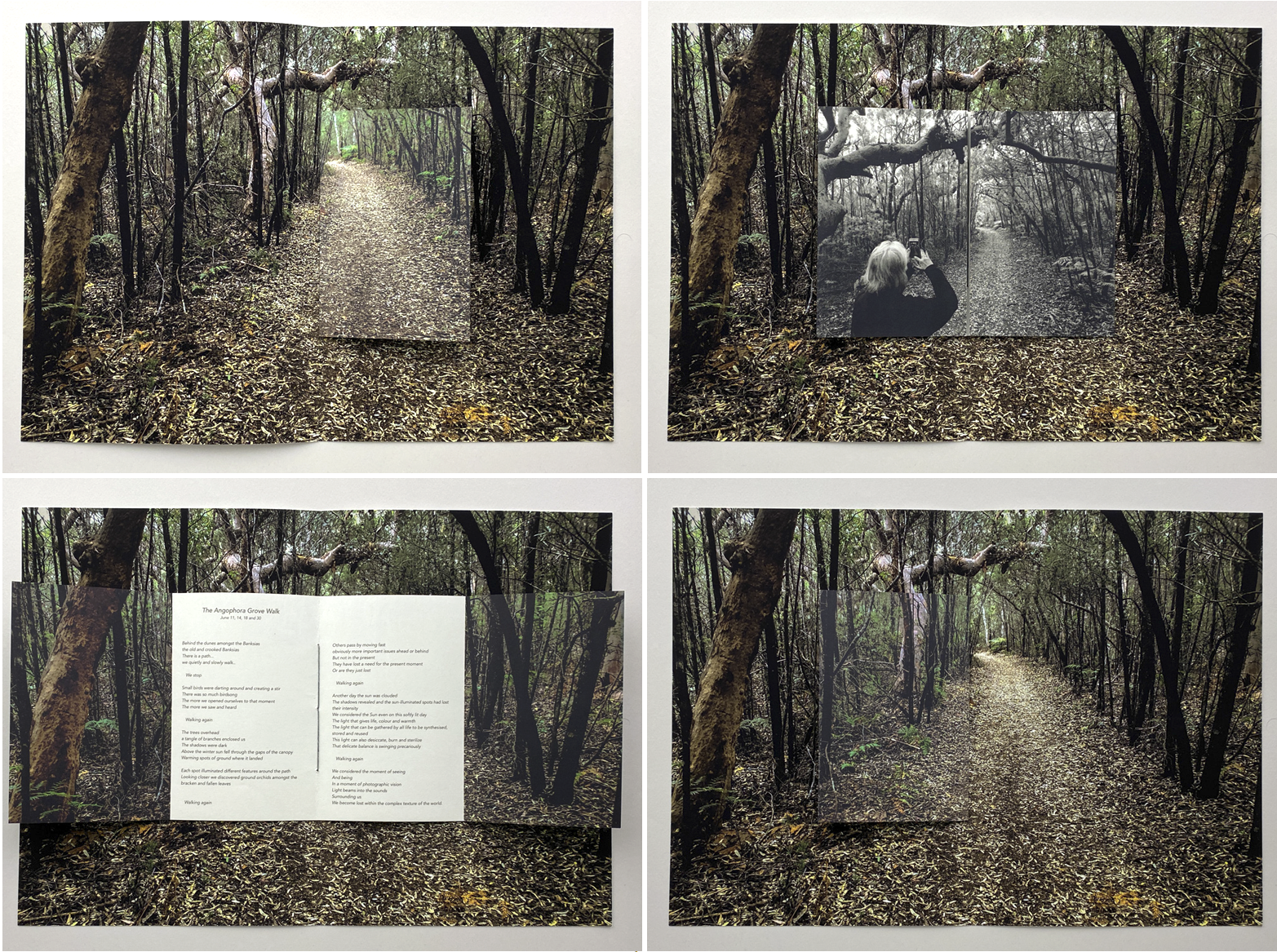
4 images of Angophora Grove Walk showing different aspects of the book
..
We designed the book so that each ‘Act’ offers an engaging haptic reading experience through unfolding the pages. In the exhibition space we were unable to show the book, therefore to give viewers an opportunity to see it in its entirety we made videos performing each ‘Act’ folio. Visitors to the exhibition can access these high definition videos via QR codes on the didactic panel next to each frame. We will also be presenting the book at specified times during the exhibition’s 3 month duration.
.
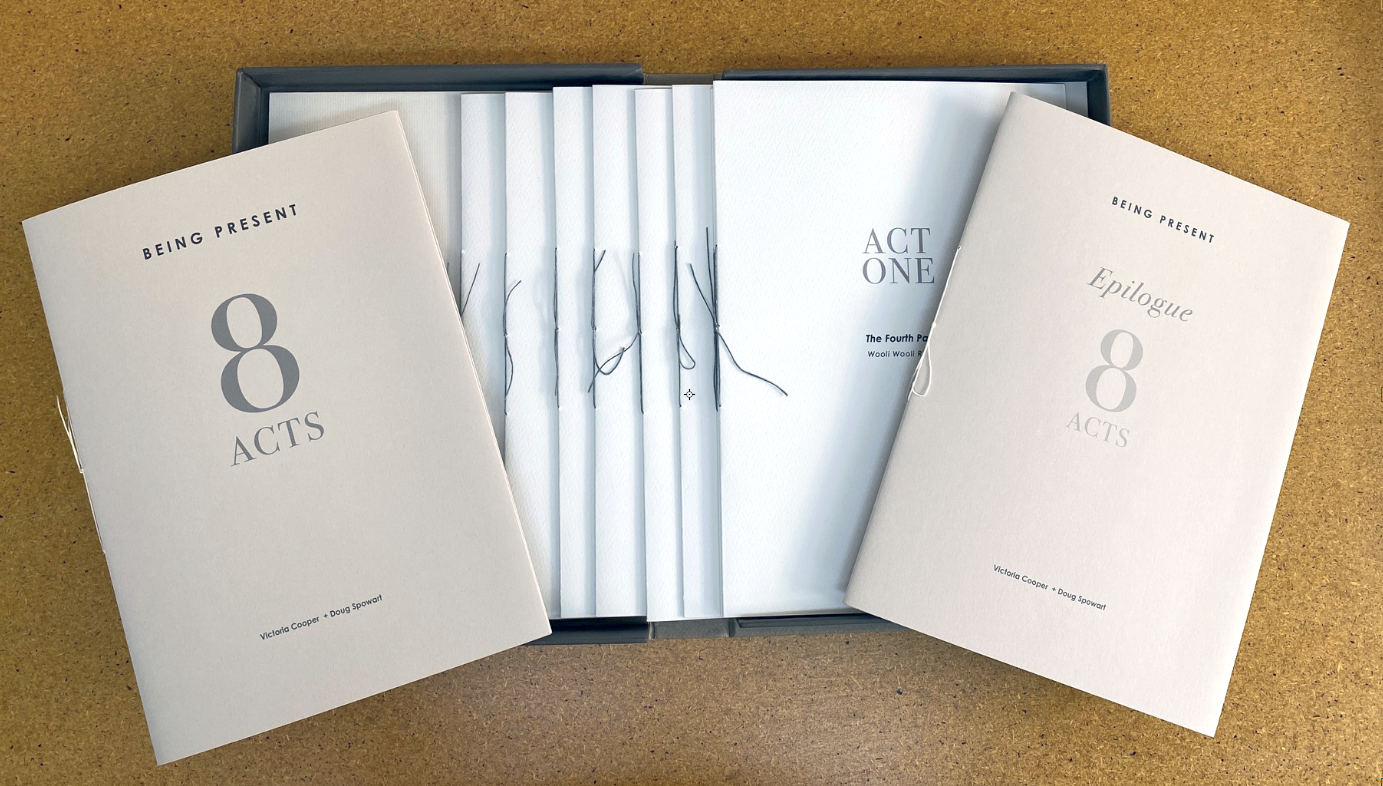
Being Present: Eight Acts book and clamshell
.
.
.
HERE ARE THE EIGHT ACTS
ACT ONE – The fourth path
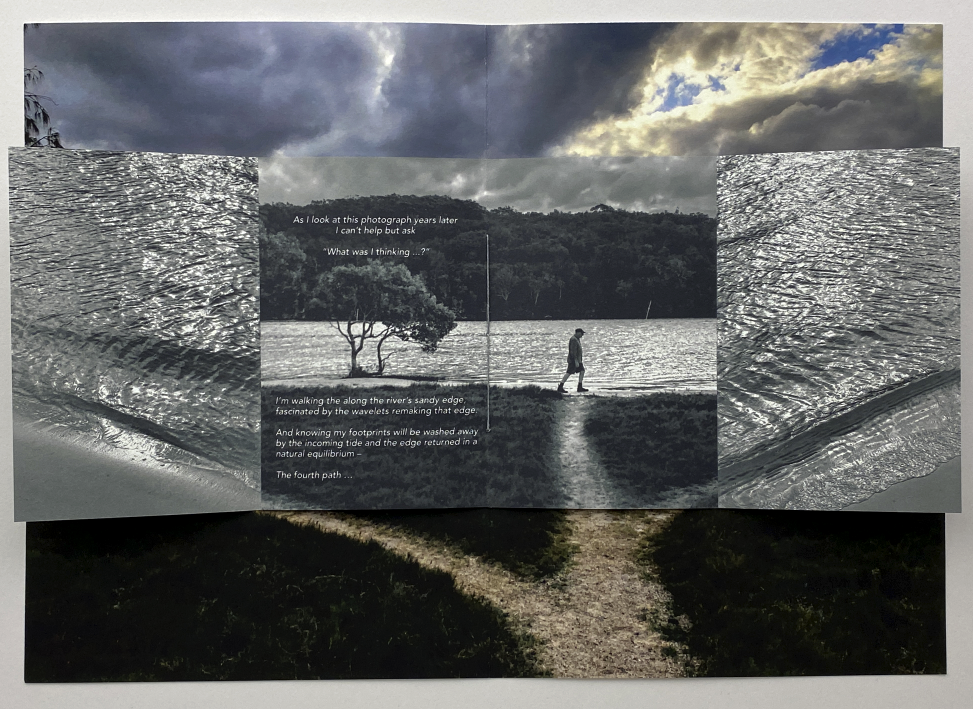
ACT 1 – The fourth path – Wooli Wooli River
TO VIEW A VIDEO PERFORMANCE of this ACT “Click” HERE
.
.
ACT TWO – Angophora Grove Walk
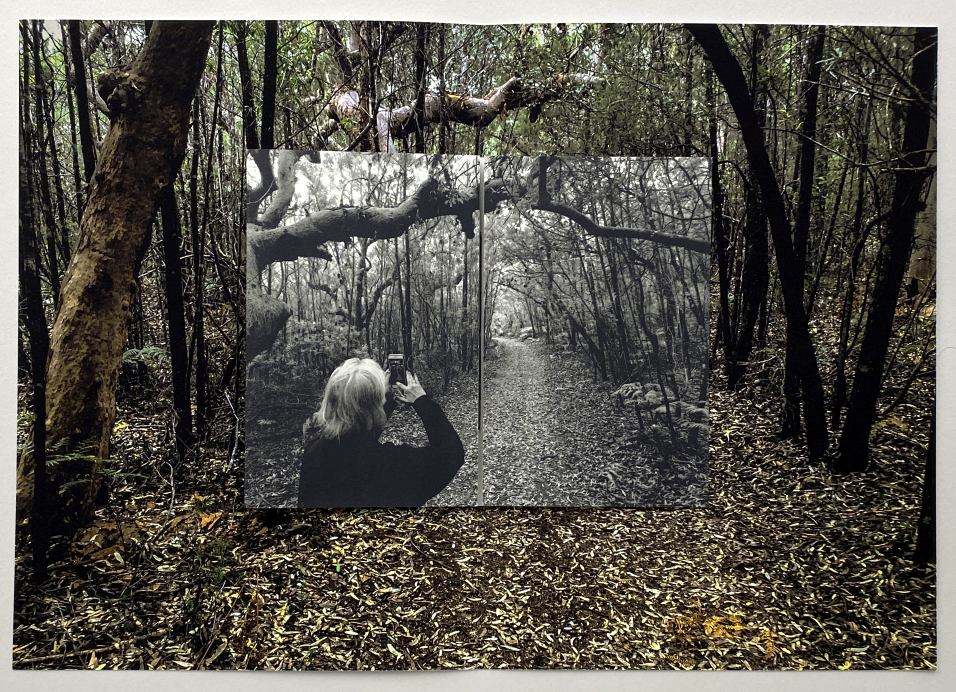
ACT 2 Angophora Grove Walk, Yuraygir National Park
TO VIEW A VIDEO PERFORMANCE of this ACT “Click” HERE
.
.
ACT THREE – Walking the Fenceline
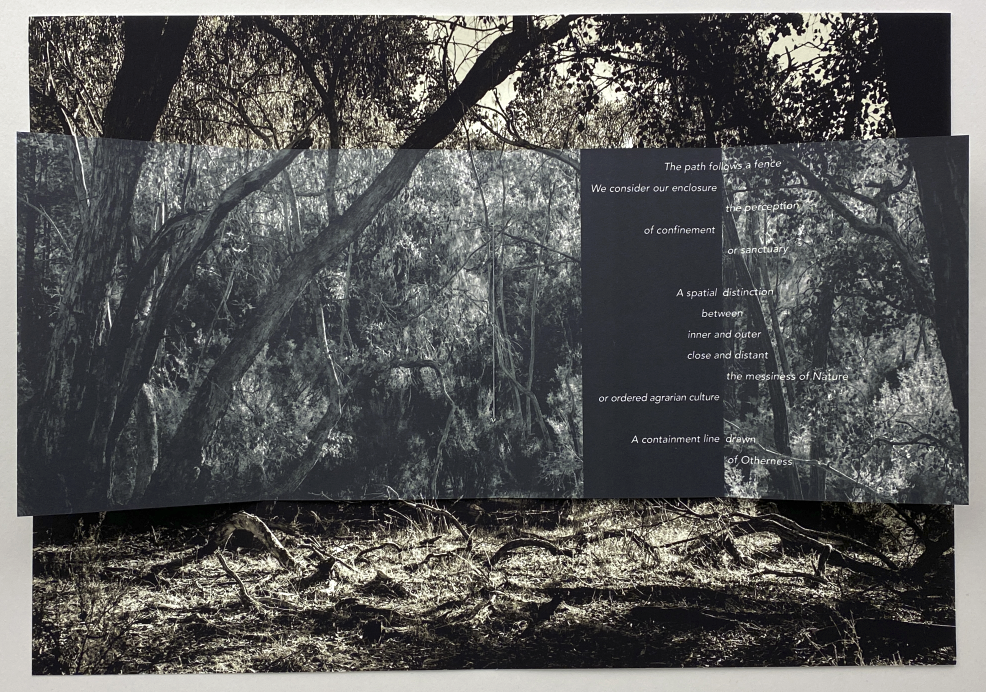
ACT 3 Walking the fenceline – Sunrise Track, Warby Ranges
TO VIEW A VIDEO PERFORMANCE of this ACT “Click” HERE
.
.
ACT FOUR – Walking Through the Thickness …
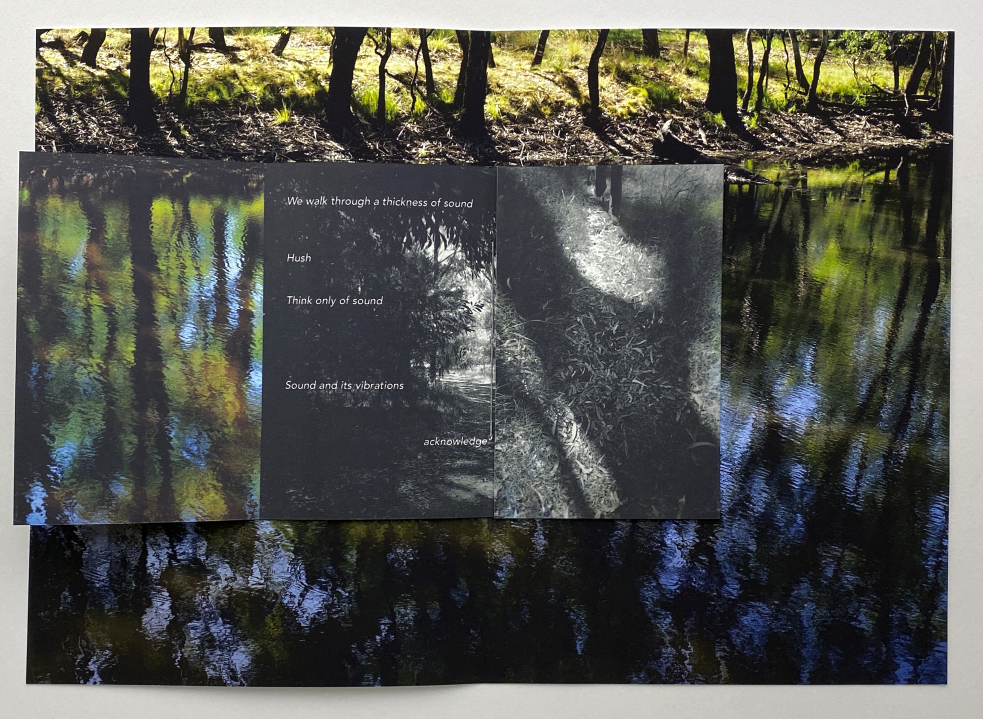
ACT 4 Walking through the thickness of sound – Ovens River, Wangaratta
TO VIEW A VIDEO PERFORMANCE of this ACT “Click” HERE
.
.
ACT FIVE – In the Presence of a Tree
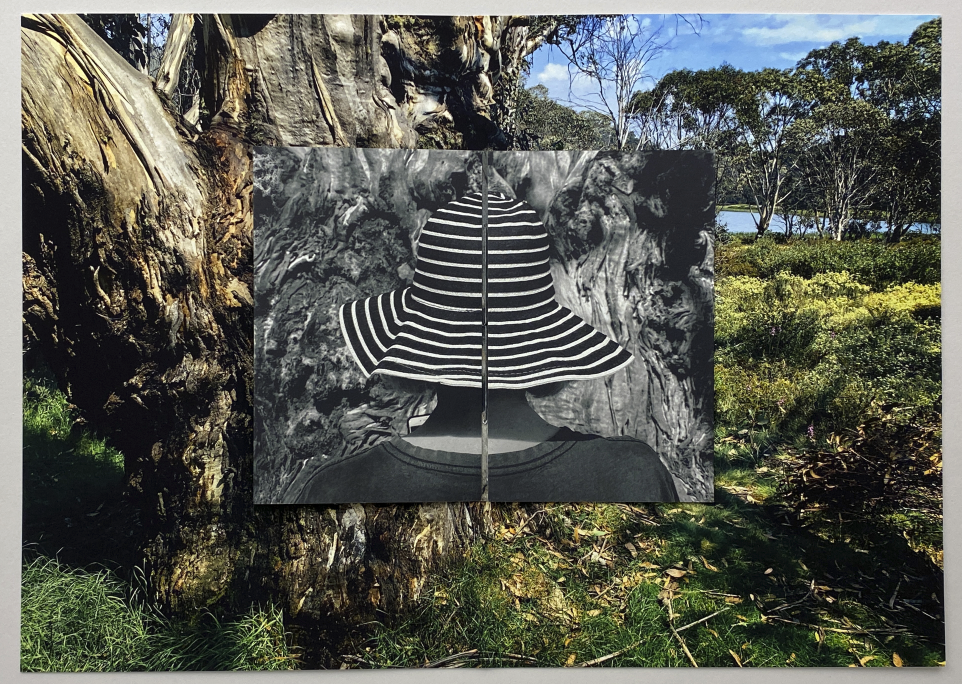
ACT 5 In the presence of a tree – Lake Catani, Mount Buffalo National Park
TO VIEW A VIDEO PERFORMANCE of this ACT “Click” HERE
.
.
ACT SIX – The Meeting Circle
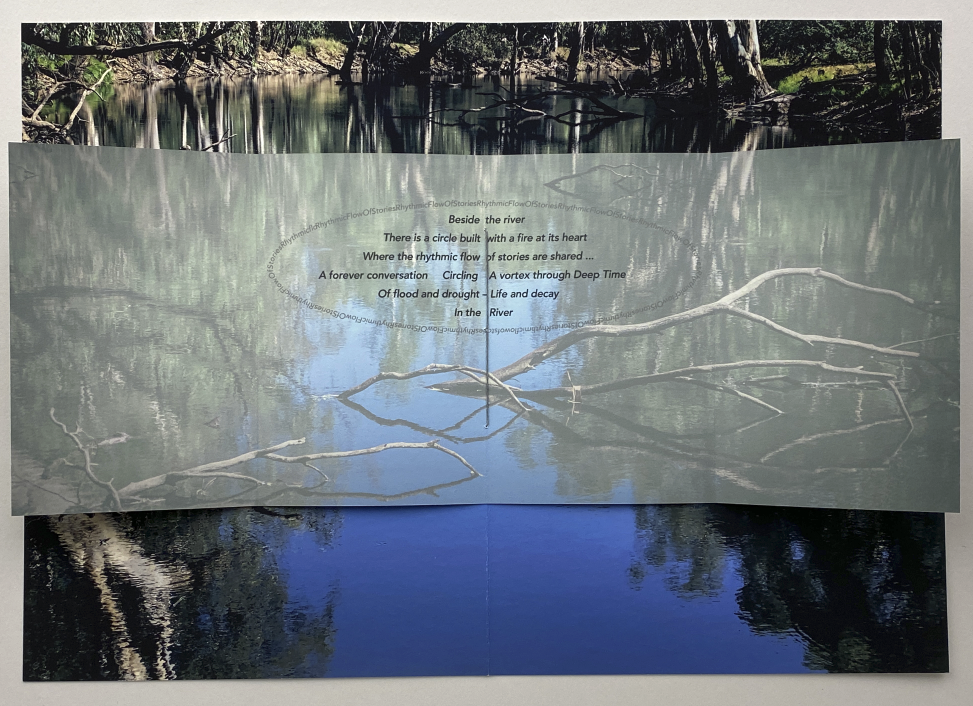
ACT 6 The meeting circle – Ovens River, Wangaratta
TO VIEW A VIDEO PERFORMANCE of this ACT “Click” HERE
.
.
ACT SEVEN – Portal, The Great South-West Walk
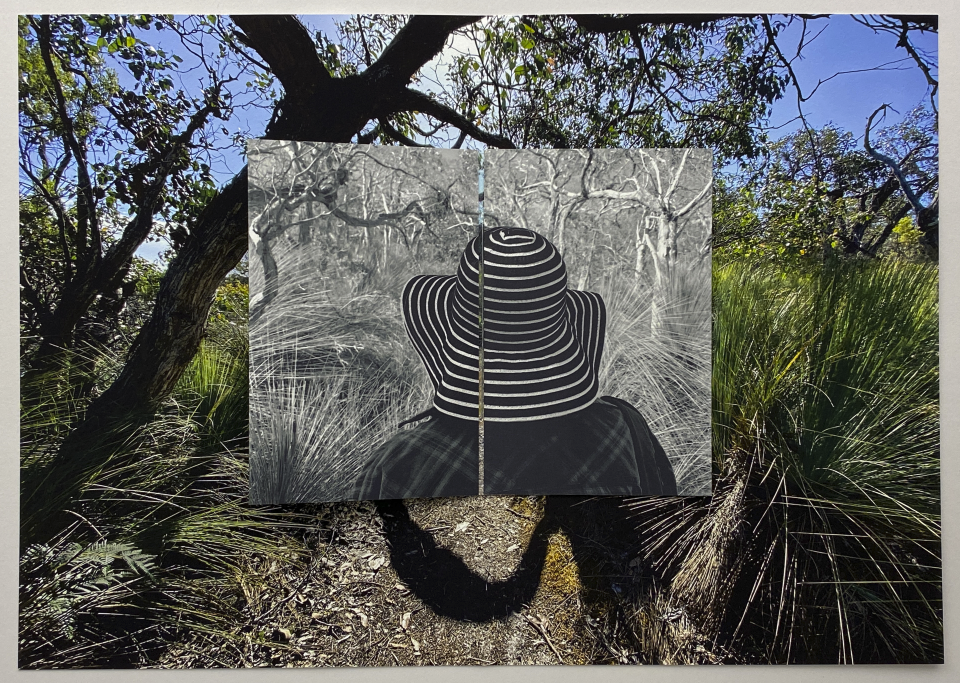
ACT 7 Portal – The Great South-West Walk, Glenelg River
TO VIEW A VIDEO PERFORMANCE of this ACT “Click” HERE
.
.
ACT EIGHT – Taking Flight, Boroka Lookout
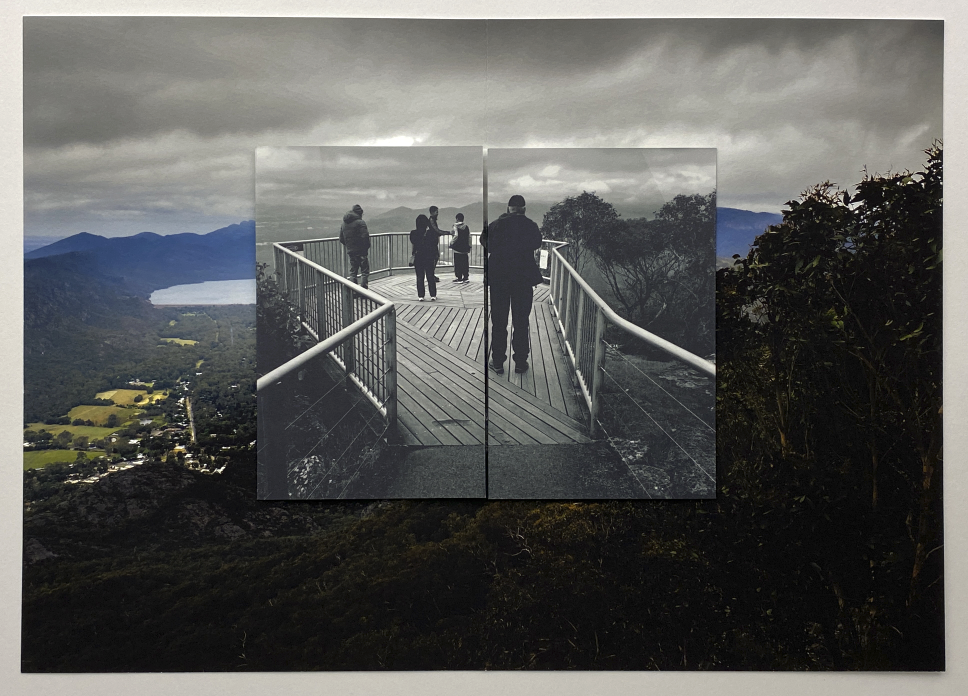
ACT 8 Taking flight – Boroka Lookout, Gariwerd National Park
TO VIEW A VIDEO PERFORMANCE of this ACT “Click” HERE
.
.
THE ARTISTS’ EPILOGUE TO THE BEING PRESENT BOOK
Throughout the development of this project, we have been informed by, and acted on, insights arising from both the physical: walking and corporeal contemplation; and the psychological: metaphorical and poetic connections with our surroundings.
Being Present is a philosophy that resonates throughout our creative careers and everyday life – underpinning our past, and as we navigate new paths.
The performance and creation of the eight ACTS has set the stage for future visual books to share, through the haptics of reading and visual metaphors, a deep connection with narratives of place.
.
.
THE MAKING OF THE BOOK
This body of work was first exhibited as a book in frames in Wangaratta Art Gallery’s exhibition space at the Performing Arts Centre in August to December 2024.
The book was resolved, printed and bound in our Bridge Street Studio in Benalla.
Being Present: Eight Acts is printed on an Epson printer with pigment inks on Epson Velvet Fine Art Paper and Zerkall printmaking papers and bound in Stonehenge covers, with Kozo Kawairi interleaved papers and waxed linen thread.
.
ACKNOWLEDGEMENTS
We wish to thank Rachel Arndt, Director of the Wangaratta Art Gallery for the opportunity for us to conceptualise, develop and create a new body of work that relates to the continuing theme in our work – Being Present.
We wish to thank Dr Felicity Rea for the access given to her family retreat at Wooli where we worked on this project. We also wish to acknowledge her continuing commentary and support of our work.
Thanks also to Cassandra Pollack for her knowledge and companionship along the Ovens River walk.
Thanks to Remy at She’s Arty in Benalla for the framing of the exhibition.
We also acknowledge the First Nations as the traditional custodians of the Country on which we have travelled through and worked. We respect their deep and enduring connection to their lands and waterways and recognise that sovereignty was never ceded.
We honour and respect their ancestors, Elders past, present and emerging and the continuation of cultural, spiritual and educational practices of all Aboriginal and Torres Strait Islander peoples.
.
Victoria Cooper + Doug Spowart
.
WATCH THIS SPACE …
.
.
A
.
.
.
.
.
.
.
.
VISITING GRAFTON REGIONAL GALLERY: June 2024
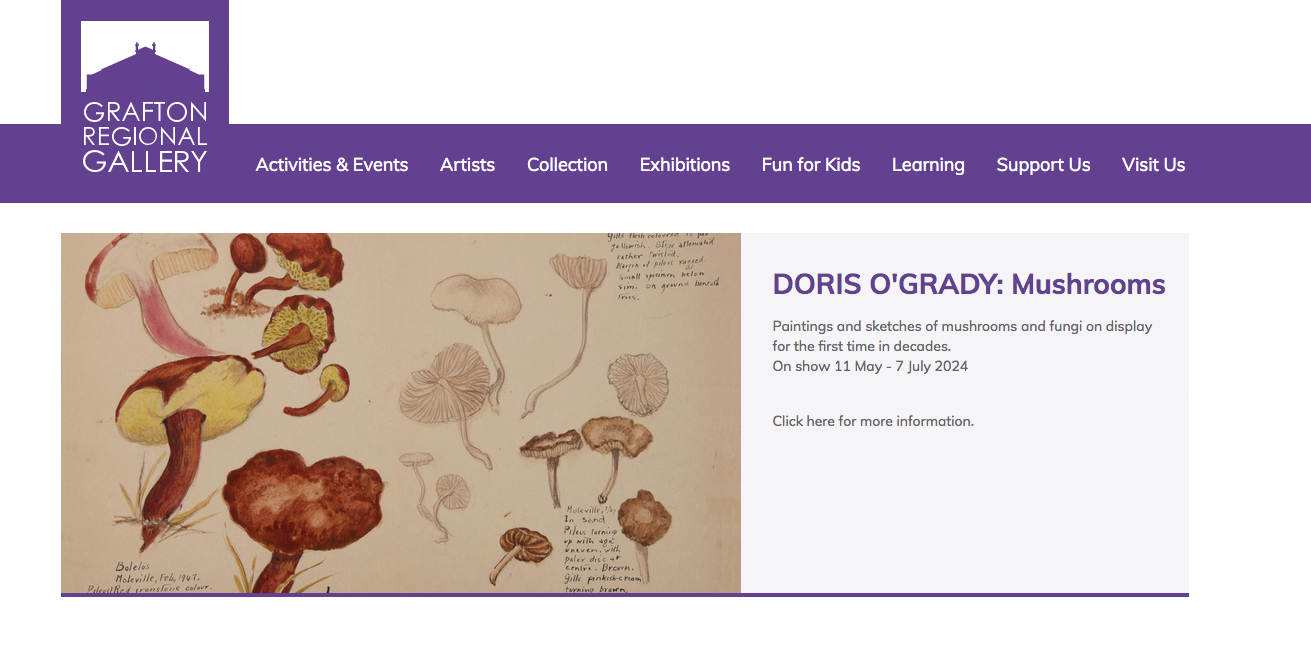
.
Regional Art Galleries exhibitions and events not only say a lot about the culture of a local community but they also provide a connection to the broader national and international world of art. These institutions are places where locals can engage with and present their stories and celebrate their creative spirits. This experience is not one that a capital city can provide – it is unique to the regional gallery and arts centre. It also provides an opportunity for local artists to be located or acknowledged within the broader art community. The Grafton Regional Gallery is one of these galleries.
.
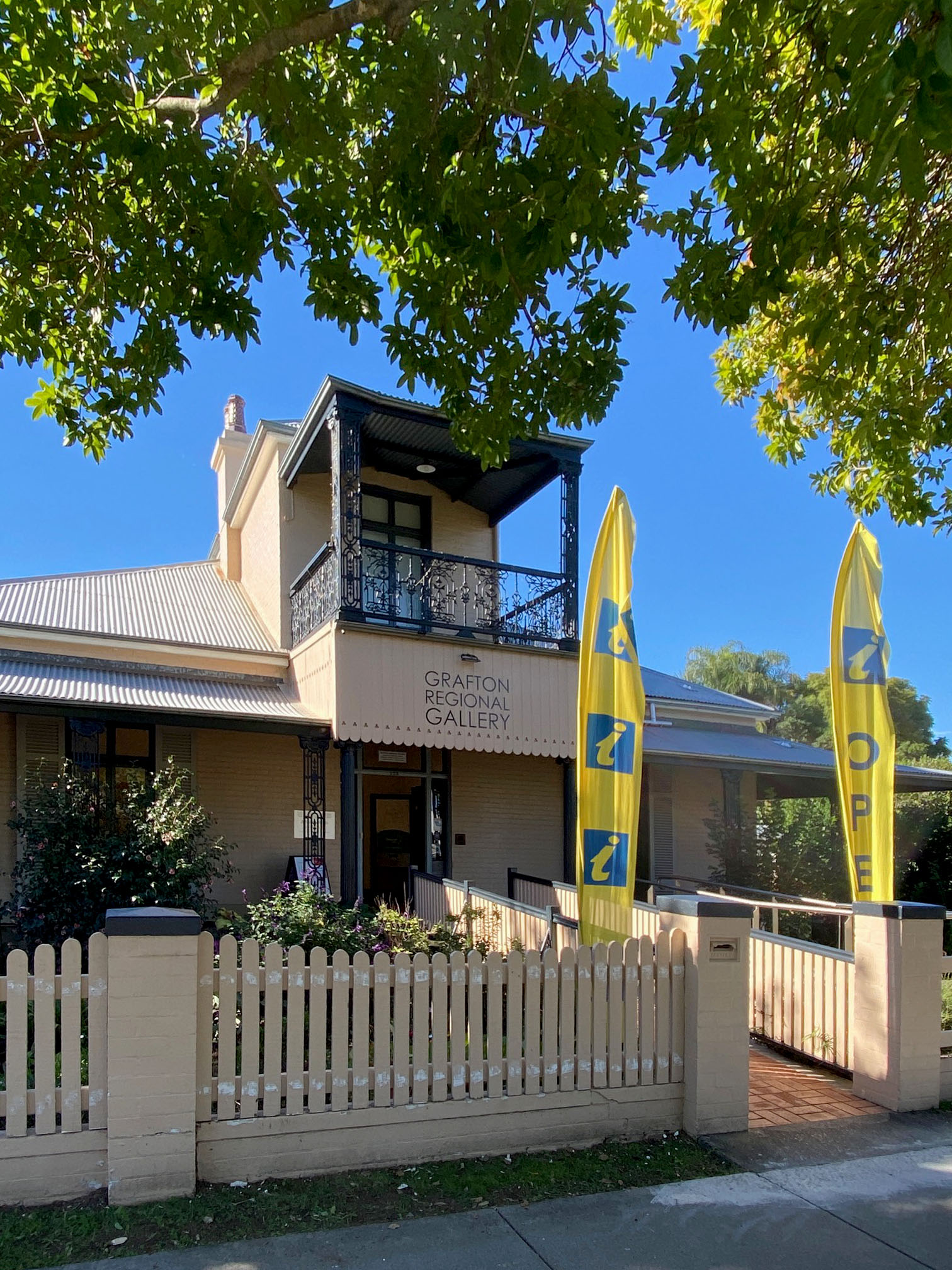
.
When visiting this region we always make time to see what is showing at the gallery and the current exhibitions were again full of interesting stories and creative work. The entrance to the front of the gallery and information centre is on the ground floor of historic Prentice House[1] . In these front rooms there is a wonderful show of botanical drawings and paintings by local artist, Doris O’Grady. O’Grady’s art can be appreciated for the aesthetics and taxonomic work she made from her collection during the mid 20th Century.
.
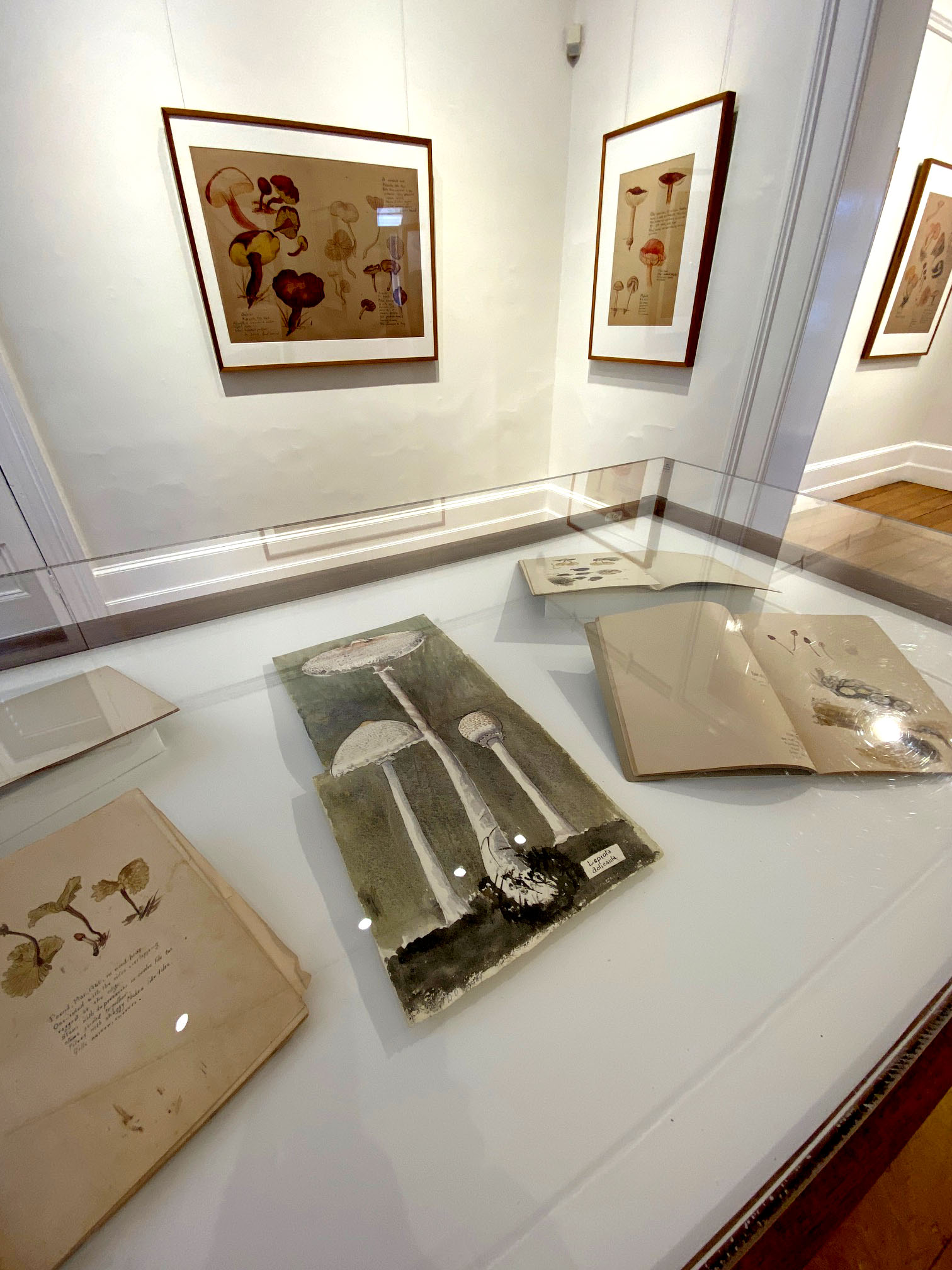
Doris O’Grady “Mushrooms” exhibition
.
Interestingly the place where we are staying in this region had some strange fungi growing in the garden about which we were curious. Amongst Doris’ paintings was the very same fungus we had seen that morning in the front garden! O Grady’s work in emblematic of the blurred lines between art and science. Where the scientist or naturalist creates interpretive aesthetic drawings of their beloved subject for both further investigation and display.
.
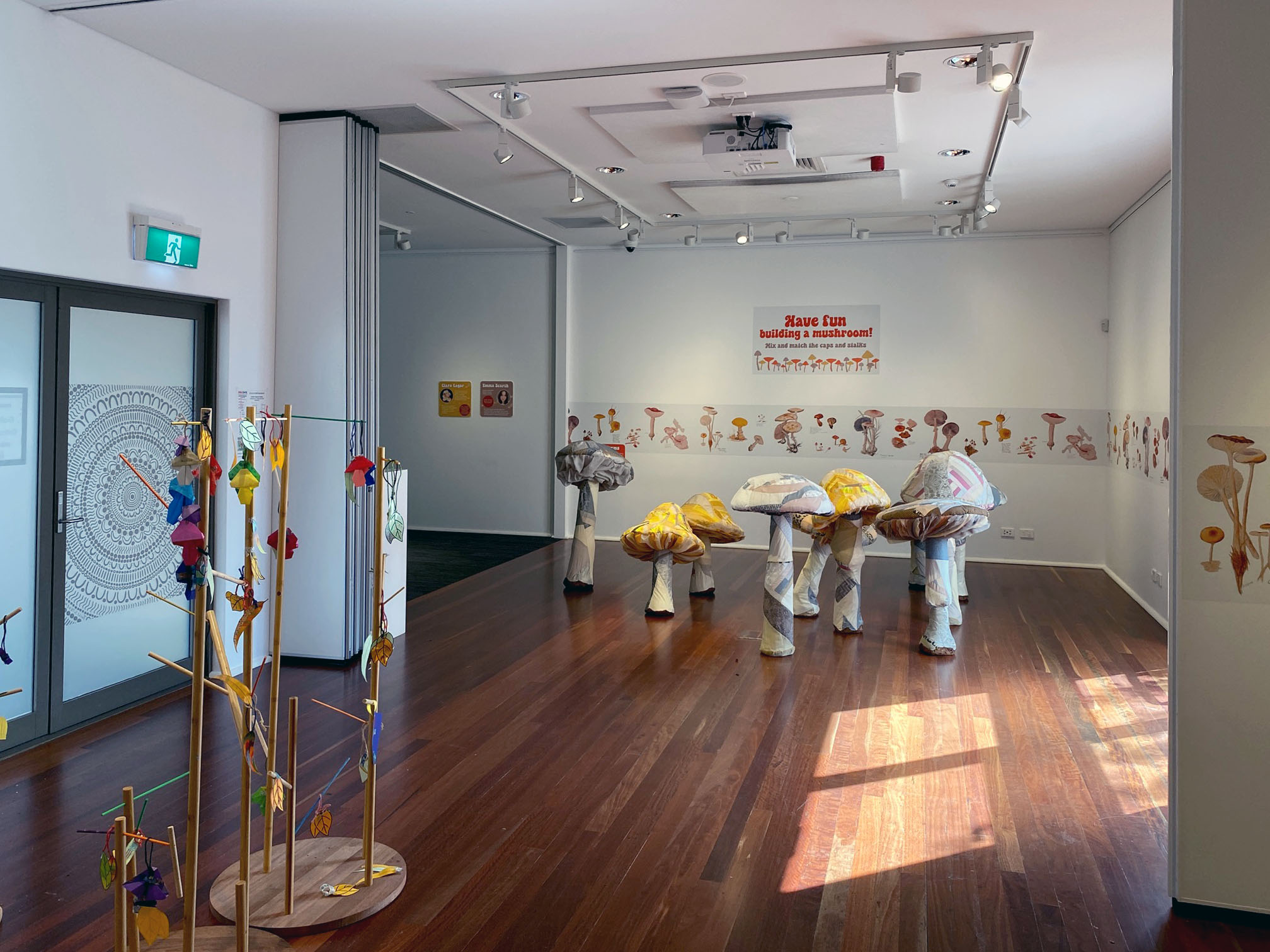
The Mush Room Family Play Space with soft sculptures by Antony Perring, Design and education by Bush Fairy animations by Clara Lagor (USA) and Emma Scarth (Canada)
.
Across the courtyard the newer second part of the gallery, we encountered a magical space inventively named, The Mush Room. Here artists and designers have playfully created a space of soft sculptures, a video and didactic wall panels. There is also an interactive drawing and sculpture for the young at heart to investigate fungi and environmental themes by creating their own work and adding leaf elements to adorn the wooden tree shapes.
.
.
In the next gallery spaces, mushrooms and fungi feature again within a larger exhibition of prints and an artists book, The Printer’s Proof: The Fred Genis Collection. Genis over his long career as a master printmaker collaborated with many nationally and internationally renowned artists including John Cage, Robert Rauschenberg, Tim Storrier, Judy Watson and Brett Whiteley.
.
.
There is a huge diversity of themes and work, the Mushroom Book by John Cage is a main feature. Pages from the book are displayed between Perspex to allow the viewer to see both sides of the pages and connect with the books conceptual design incorporating lyrical texts and visual elements. The bound book was displayed in a vitrine adjacent with some archive documents of the production and sale.
.
.
Artists Proof is a comprehensive exhibition bringing together a history of art and printmaking, the artists and studios. It is an exhibition that would appeal to many particularly those wanting to touch with the practice of Genis and his contemporary colleagues. There is the potential for many discussions around the individual works as objects and concepts, of and for their time in art.
We will return to the gallery as to fully engage with the depth of these exhibitions will take more than one visit.
Victoria Cooper
[1] For more history see https://galleryfriends.com.au
.
.
Grafton Regional Gallery
June 2024
Exhibitions, 11 May to 7 July 2024
Doris O’Grady: Mushrooms
The Mush Room
The Printer’s Proof: The Fred Genis Collection
.
All photographs by Doug Spowart Text by Victoria Cooper
.
.
.
.
.
.
.
.
.
A Poem for Dad on ANZAC DAY – Victoria Cooper
.
My father Reg Cooper served in the Royal Australian Air Force in Papua New Guinea in World War II. During this time he made this work by collecting butterflies and placing them over a map of PNG and framing. It is entitled “Nadzab 1944” – where he was stationed.
Remembering small shared moments of joy for the natural world.
Many of which no longer exist but for a museum of memories.
With gratitude to my father
.
Pneumas
.
Flashes of colour
Flutter across the wall
The souls of the warriors
Fly over
The sublime terrain
While pinned
To a never ending present
.
Years pass
This man
Tends a distant garden
Preparing a fertile space
In anticipation for the end of dormancy
.
And so the decades
They fly
This man and a small child
Tend the garden
With humility in everyday work
Merging into a gentle rhythm
No expectations
Just joy in the flowers
That simply grow
.
But the Butterflies
Remain
Souls Hovering
Over that memory
What do they know
About Time…..
.
Eventually
The child alone
Tends the garden
Now a field
Rich with Dreams
Of Flowers
And Forests
.
All this …
For The Butterflies
To breathe
.
*Pneuma (πνεῦμα) is an ancient Greek word for “breath“, and in a religious context for “spirit” or “soul“.[1]
.
.
.
.
.
.
This Blogpost is copyright: Text – Victoria Cooper ©2020, Nadzab 1944 © Reg Cooper, Portrait of Victoria & Reginald Cooper – Helen Cooper ©circa1960
Any RSS reposting from this Blog without permission represents a breach of Copyright.
.
.
.
.
.
JULIE MILLOWICK’s ‘Surrounding’– Intrinsically Local

Continuing Drought El Nino year – Julie Millowick with son Christian McArdle at Crocodile Reservoir PHOTO: Courtesy of the artist
.
SURROUNDING
The beauty of Central Victoria’s landscape in tumult and recovery
.
An exhibition by Julie Millowick at Castlemaine Art Museum

CAM – Surrounding Julie Millowick
.
“Photography is my life; it is the very core of my being”
Julie Millowick
Surrounding is an exhibition by Julie Millowick surveying her lived experience over 36 years in Fryerstown, Victoria. Over time this celebrated documentary and commercial photographer, driven by a curious and creative mind, has created a photographic archive both cataloguing her visual inquiry and providing a chronicle of her life within this place. Millowick’s work is multifaceted where the poetic and psychological is interconnected with an almost scientific aesthetic thus sharing deep insights into the land that has both nourished and challenged her.
The curator, Jenny Long, has written a sensitive and informative essay for the book Surrounding that accompanies the exhibition. Long discusses Millowick’s process and conceptual thinking along with observations to provide background and framework for the viewer to consider this extensive project. Along with the book there is promotional material and didactics that proposes the exhibition will ‘show us the devastating effects of mining, drought, flood and invasive plants, but also remind us of the interconnectedness that links all parts of this ecosystem including its human occupants.’ And that there is a, ‘capacity for renewal … that offers a spark of hope for the future.’
.

Surrounding House and domestic installation PHOTO: Supplied by the artist
.
In the first gallery space, the ‘house and domestic’ body of work is presented as twenty-three individual framed works including an 1870s photograph an original owner, Mrs King, standing outside the home. In this work Millowick’s subject matter includes botanical still-life works, images of the detritus of past inhabitants unearthed in the house grounds and there is also a large print of a section of a house wall interior etched with the marks of habitation and the patina of age. Images of washing drying on the clothesline refer to the domestic space of the past and present habitation of this home. Far from being prosaic records of domesticity, the photographs of the washing have an ethereal perhaps even ghostly appearance.

Washing in Horse Paddock pinhole image 1996 PHOTO: Courtesy of the artist
.
There is also a kind of haunting in the walls and surrounds of the house, which continues through the shadowy and dramatically lit scenes of this exhibition. The appearance of a selectively illuminated tree branch or the enchanted presence of Millowick’s horse Goldie, imbues the place with a mythical spirit that beckons the viewer to follow into the mysterious dark forest.
.
.
Contrasted with a sense of wonder and fairy tale mystery, Millowick’s work is also deeply grounded in the reality of place, which is as sharp and unadorned as the land itself. In the larger exhibition space, there are groupings of unframed images that explore both topographical and psychological aspects of specific spaces and themes including mine sites, the Castlemaine Diggings National Heritage Park, ecological thinning, the Crocodile Reservoir Drought and horse paddock. A constant subject for Millowick is her son Christian whose activities are documented in many of these themes. images within the groups are placed together to form clues and evidences that suggest larger narratives. It is also interesting to consider the installations as visual representations of the conversation between artist and curator piecing together the rich collection of work and the resonance or dissonance between images and concepts.
.

Invasive Thistles 2002 Lumen print by Julie Millowick
.

Goldie, 34 year old horse 2009 PHOTO: Julie Millowick
.

Horse Paddock Post Goldrush Uniform Regrowth PHOTO: Julie Millowick
.

Fryerstown, Isolation, Lockdown, Orchard, Chinese Pistachiola Tree, last moments before midnight on 21 October, and first moFryerstown, Isolation, Lockdown, Orchard, Chinese Pistachiola Tree, last moments before midnight on 21 October, and first moments on 22 October PHOTO: Julie Millowick
.

Original Cottage Wall with introduced Invasive Blackberry 2023 PHOTO: Julie Millowick
.

Fryers Diggings, Sluicing, Heron’s Reef 2023 PHOTO: Julie Millowick
.

Crocodile Reservoir 2006 PHOTO: Julie Millowick
.

Drowned Kangaroo PHOTO: Julie Millowick
.

Lumen Buried Paper Under Blackberry Bush by Julie Millowick
.

Castlemaine Diggings National Heritage Park Cherry Ballart 2022 PHOTO: Julie Millowick
.
A photographer with less time moving over the space would document the superficial surface of things and create a record time-locked to when they were there. Millowick has set for herself the challenge of distilling a life of experience of time and place by using her comprehensive knowledge of photographic techniques* that, when combined with personal vision, can present to the viewer something deeper. As Millowick explores the environment or found objects, she reveals deeper layers and meanings through her experimentation with the visual language of each process and technique. The depth and complexity of this work tells of the unwavering commitment to her art, the community and the environment.
.

Image grouping
.
When introducing Julie Millowick at a recent artist’s talk about her exhibition the Gallery Director Naomi Cass described her as a ‘Localist’. ‘Localist’ is indeed an appropriate term not only for the work in this exhibition but also for Millowick’s continued photographic activity in the community. As a localist Millowick’s activity is part of the growing contemporary global movement for living locally and telling local stories particularly since the impacts of the Covid Pandemic. As it was 36 years in the making, this exhibition could only be just a fragment of Millowick’s creative visual documentation of her surroundings and community. Further digging or mining of her extensive archive will potentially reveal new perspectives and meanings on these powerful local stories of her place. Surrounding is just a beginning, there are so many other stories yet to be told …
.
A commentary on the exhibition by Victoria Cooper and Doug Spowart
Surrounding was part of the PHOTO2024 program
.

Surrounding – the book
.
P.S. The Surrounding exhibition is complemented by an illustrated book copies of which can be purchased from Castlemaine Art Museum or directly from Julie Millowick
.
IMAGES FROM THE IN CONVERSATION EVENT | Julie Millowick and Kyla McFarlane
Sunday 10 March, 11:30am — 12:30pm
.
.
* Photographic techniques that Julie Millowick employed in the exhibition include – pinhole photography, lumen printing, added lighting (painting-with-light), double exposure, cyanotypes, out-of-focus capture, re-photography, progressive sequencing, documentary and personal narrative.
We wish to thank Julie Millowick and congratulate her on the exhibition and for the images of her photographs and the exhibition installation. Photographs of the IN CONVERSATION event were by Doug Spowart.
Castlemaine Art Museum is a member of the Public Galleries Association of Victoria
.
.
.C
.
This site is archived by PANDORA, Australia National Library’s Web Archive
.
.
.
.
.
.
.
DOUG GOES WHERE THE SURFERS HAVE NO WAVES – Again…!

.
IPPY DROPS IN … AND RIPS!
The exhibition reprise after 30 years
.
THE PHOTOGRAPHIC COMPONENT FROM DOUG SPOWART: Read more later in the post
Click on the photo to enlarge …
.
.
THE VIDEO COMPONENT FROM KATE ELLOVEE:
.
The inspiration for the original exhibition was Kate Ellovee (Versace) who was working on a documentary project commenting on surfers who live at Ipswich and surf on the north and south coasts – much to the dislike of the locals. Entitled A Slagheap Safari the video takes centre stage in the reprise of the exhibition.
.
.
Kate’s A Slagheap Safari video can be viewed HERE
.
A mini booklet of the exhibition can be downloaded: Ippy Drops In and Rips Booklet
.
.
The exhibition will be on show in the Ipswich Community Gallery, d’Arcy Doyle Place, Limestone Street, Ipswich until the 22nd of December 2023.
.

IPPY-Australian Photography Cover
.
Back in 1993 my work in the exhibition was featured in Australian Photography – the story inside added to the craziness of the whole project …
Click to enlarge text …
.

Australian Photography story p1 of 3

Australian Photography story p2 of 3

Australian Photography story p3 of 3
.
.
A reflection on the project by photographer Doug Spowart
Background to my work
I have a forty-year practice in conceptual photography. This approach to photography so profoundly directed my work that in the late 1980s my business card described my art practice as ‘Conceptual Photographer’. The methodologies of re-photography, photomontage sequential imaging and the use of a range of photo technologies and materials underpinned the conceptualisation, creation and presentation of the creative work. I look for the strange and the surreal or the sublime in everyday life addressed through irony and humour. I am always absorbed by how the mundane and ordinary can hold hidden moments of surprise if time is taken to see what is revealed.
The Ippy Drops in and Rips Project
In 1993 I received a phone call from Elizabeth Bates a curator at Ipswich Art Gallery. I had worked with Elizabeth at Araluen Art Gallery in Alice Springs a few years earlier on a documentary exhibition commenting on the tourist experience in Central Australia, so she was aware of the style of my photographic work. Elizabeth introduced the project she was working on with Kate Ellovee (Versace) in which Kate was to create a documentary video commenting on Ipswich’s landlocked surfers. It was suggested that I could create photography works that would complement the video presentation in the gallery. In the initial project development meeting with Kate she discussed the concepts behind the ‘A Slagheap Safari’ documentary video. Her project was full of the curiosity, irony, and humour that had resonance with my approach to documentary work.
My partner and fellow artist Victoria Cooper and I were intrigued by the idea that there was such a strong surfing culture in Ipswich. It seemed surreal to us and we wondered: where could we find a concept of surf or surfing in this mining town at the western edge of Brisbane? Who were these surfers and how did they navigate the cross-over from Ipswich to beach?
After contemplating these questions I put forward a proposition consisting of three concepts: (1) Re-photography portraits – commenting on the dual identities that surfers have living and working in Ipswich and yet maintaining a surfing life on the weekend down the beach, (2) ‘Hold-ups’, where I would search Ipswich town settings and mining landscapes for evidence or connection with the beach or surf and (3) Photomontages – through improbable interventions I would metaphorically bring the surf and surfers to Ipswich. Clearances were provided by surfing photographers and the pictured surfers for their photographs to be photomontaged with Ipswich location scenes.
In making the photographs we sometimes collaborated with Kate and at other times we worked independently. Kate’s energy and coordination skills were important to the project as surfers usually have one specific thing in mind – surfing. With Kate we went to the beaches to seek out these Ippy surfers in their preferred natural environment. In this quest we too “searched for the best waves” to find the surfers. Interestingly the Ippy project was pre the proliferation of mobile phones, so we needed to check the radio’s ‘best waves’ reports, we then went to the beaches and then looked out for the surfer’s cars, boards or the surfers themselves.
Working on the project’s themes Victoria and I would cruise around Ipswich looking for places that resonated with the concepts of beach and surfing. Gradually these were revealed to us: the top of a water tower with skateboarders, a tunnel leading into the mine, navigating a graffiti covered underpass, a mine cutting that looked like a wave. Each place we found was evocative and full of potential metaphors of surfing culture within this inland mining town.
A Concluding Comment
Documentary projects, either as video or photography, have the potential to tell stories and create a commentary on contemporary culture and social life. Thirty years on, the Ippy Drops in and Rips show returns to a new era, a new audience, and for those who participated in the original project, a possibility to recall memories of a different time.
In re-viewing Ippy Drops in and Rips Ipswich surfing culture story, perhaps not much has changed – or has it? Is the credo of the Ipswich surfing culture – surf to live and live to surf, still as strong as ever … ?
And finally … Do north and south coast locals cuss the new generation of Ipswich surfers when they “DROP IN … AND RIP …?”
.
.
Doug Spowart+ Victoria Cooper November 12, 2023
.
.
Thanks to Kate Ellovee for resurrecting the Ippy exhibition after 30 years and to Alison McKay and Ellia Shurte from Ipswich Art Gallery for their support with the exhibition. And also to Thomas Oliver and John Elliott for the photos.
.
.
.









































